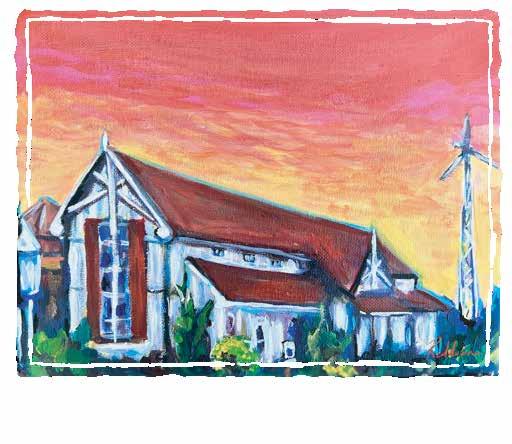FORCES NATURE



“My custom order came faster than anyone else could deliver. The people at Nags Head Hammocks were on top of it every step of the way”




Us, neither. But maybe we should have.
Back in 1992, two UVA professors — Robert Dolan and Robert E. Davis — revealed their own Saffir-Simpson-style system for measuring winter nor’easters, assigning categories from 1 to 5 to cover impacts ranging from minor overwash to massive losses. Their reasoning? As the pair wrote in Scientific American, while these regular winter storms may be “perceived as less dangerous,” the potential for coastal damage can be “comparable to or exceeding that of a hurricane.” The pair concluded: “as population density along the Atlantic Coast continues to increase, nor’easters will have an even greater impact upon coastal residents.”
And while the goal was to warn citizens from Palm Beach to Portland of potential catastrophes, guess where they got the gory guts of their destruction data? Yep — right at Cape Hatteras, where they studied the wave heights, wind-speeds and sand loss across 1,347 storms over 40 years of records.
In other words, when it comes to nor’easters, no stretch of shoreline gets hit harder — or more frequently — than the Outer Banks.
Of course, this is hardly news for anyone who’s lived here a winter or two. We’re all too aware that while Big Named Storms hog all the attention, it’s the sneaky winter lows that cause the bulk of our headaches. Or, in the case of 1962’s Ash Wednesday storm, sucker punch you into near oblivion. So, when we realized that this past March marked the meteorological monster’s 60th Anniversary, we thought we’d look back on some of our other offseason ogres, then try to get a sense of what’s in store for future generations.
And guess what we found? Not a whole lot. Turns out, while the scientific community can’t stop obsessing over how a warming planet might influence other natural disasters like droughts, wildfires and hurricanes, there are only two published papers studying the impacts of climate change on nor’easters.
Apparently, despite the boom in lives, buildings and infrastructure along the Eastern seaboard in recent years, the innerworkings of nor’easters remain a fringe concern.

The people who don’t seem too distraught? All the local boots on the ground. The Chicamacomico firefighters who’ve pulled more visiting families from flooded oceanfront rentals than they can remember. The DOT workers who relentlessly fight overwash along Pea Island, so all of NC 12 can just keep moving. Even the emergency management officials charged with keeping us safe.
To them, all folks should worry about is whatever storm is coming at us at any given moment, and the damage it’s expected to bring. Because they know even the least menacing-looking weather system can still be a disaster — even if it’s just for a single house or isolated stretch of pavement.
“Whether it’s a nor’easter or just a low pressure system off the coast that’s bringing big swells during a high tide cycle, impacts can come at any point in time,” said Dare County’s Director of Emergency Management, Drew Pearson. “So, nobody should focus on the category of a storm. Nobody should focus on if it’s ‘just a nor’easter.’ Everyone should focus on ‘what is this storm going to bring to our community?’”
And when those impacts are serious, people need to act.
Live near the sound when it’s howling southwest? Move those cars. Thinking of chasing waves on the heels of a hurricane? Monitor those overwash updates. If you moved here recently, ask a longtime local how bad it can get. And just ’cause you’ve lived here your whole life, don’t assume you’ve seen it all.
As Pearson notes: “Events that may not have brought impacts in the past are bringing impacts now — and they will into the future.”
Clearly, the Dolan-Davis scale never caught on. In fact, 30 years later, this noble attempt to keep coastal heads above water remains little more than a footnote in the meteorology books. Maybe nor’easters will garner more serious scientific attention as even more people move from inland areas and into harm’s way. Maybe it’ll take another Ash Wednesday to rattle researchers into action.
One thing’s for sure: we’ll all find out the hard way.
— Matt WalkerThank you for reading Outer Banks Milepost. We hope you enjoy it. If not — before chucking this issue into the nearest dumpster — please consider one of the following equally satisfying ways of expressing your disgust: cut up a running a collection of weather flags, from gale-warning to hurricane; wedge some copies under the door to block storm surge before the next big one hits. Or simply toss it on that six-month stack of newspapers you’ve yet to recycle. (Trust us, you’ll feel better.) Then, send any and all feedback — positive, negative or just plain confused — to: editor@outerbanksmilepost.com. We promise to find some way to re-purpose them.
“ WHEN IT COMES TO NOR’EASTERS, NOBODY GETS HIT HARDER THAN THE OUTER BANKS.
“What’s in a name?” — William Shakespeare “This blows.” — Anonymous
Issue 11.4

Winter ’22/23
Cover: Noir’easter.
Photo: Daniel Pullen
Reader You Brushes & Ink

Carnell Boyle, John Butler, Ginger Che, Love Che-Howell, True Che-Howell, George Cheeseman, Marcia Cline, Carolina Coto, Kim Cowen, Cloey Davis, Michael J. Davis, Fay Davis Edwards, Mary Edwards, Laine Edwards, Marc Felton, Travis Fowler, Adriana Gomez-Nichols, Chris Gray, Andy Howell, John Jones, Amelia Kasten, Chris Kemp, Nathan Lawrenson, Dave Lekens, Alex Lex, Tim Lusk, Elisa McVearry, Ben Miller, Dawn Moraga, Ben Morris, Holly Nettles, Stella Nettles, Rick Nilson, Barbara Noel, Holly Overton, Stuart Parks II, Charlotte Quinn, Willow Rea, Meg Rubino, Shirley Ruff, Mark Slagle, Noah Snyder, Rob Snyder, Janet Stapelman, Alyse Stewart, Kenneth Templeton, Stephen Templeton, George Tsonev, Christina Weisner, John Wilson, Mark Wiseman, Bri Young, Mike Zafra Lensfolk
Nate Appel, Matt Artz, Chris Bickford, Russell Blackwood, John Bliven, Mike Booher, Don Bower, Aycock Brown, Mark Buckler, Jon Carter, Garnette Coleman, Rich Coleman, Marc Corbett, Kim Cowen, Chris Creighton, Mere Crockett, Jason Denson, Amy Dixon, Susan Dotterer Dixon, Lori Douglas, Julie Dreelin, Tom Dugan/ESM, Roy Edlund, Bryan Elkus, Ben Gallop, Cory Godwin, Cody Hammer, Chris Hannant, Katie Harms, Bryan Harvey, David Alan Harvey, Ginger Harvey, Bob Hovey, Biff Jennings, Jenni Koontz, Mike Leech, Anthony Leone, Jeff Lewis, Jared Lloyd, Matt Lusk, Ray Matthews, Brooke Mayo, Mickey McCarthy, Nic McLean, Roger Meekins, D. Victor Meekins, Richard L. Miller, Dick Meseroll/ ESM, David Molnar, Rachel Moser, Ryan Moser, Elizabeth Neal, Rob Nelson, Candace Owens, Anne Snape Parsons, Crystal Polston, Daniel Pullen, Ryan Rhodes, Terry Rowell, Cyndi Goetcheus Sarfan, Katie Slater, Tom Sloate, Wes Snyder, Aimee Thibodeau, David Thomas, Ed Tupper, Eve Turek, Chris Updegrave, Dan Waters, Kati Wilkins, Cyrus Welch, Jay Wickens
Penfolk
Ashley Bahen, Madeline Bailey, Sarah Downing, Laura Gomez-Nichols, Jim Gould, Steve Hanf, Dave Holton, Sarah Hyde, Catherine Kozak, Katrina Leuzinger Owens, Dan Lewis, Terri Mackleberry, Fran Marler, Matt Pruett, Mary Ellen Riddle, Peter Graves Roberts, Arabella Saunders, Corinne Saunders, Sandy Semans, Shannon Sutton, Kip Tabb, Kathleen Wasniewski, Hannah West, Clumpy White, Sharon Whitehurst, Natalie Wolfe, Michele Young-Stone
Pointing/Clicking
Jesse Davis Sales Force
Laurin Walker
Big Mouth In Chief
Matt Walker Blame It All On Suite P Inc. PO Box 7100 • KDH, NC 27948
Office: 252-441-6203 • Sales: 949-275-5115
editor@outerbanksmilepost.com • sales@outerbanksmilepost.com
Outer Banks Milepost is published quarterly (sorterly) by Suite P Inc. All contents are the property of Suite P Inc. and do not reflect the opinion of advertisers or distributors. Nor do their contents reflect that of the creative types (who would never, ever sell out). Comments, letters and submissions are usually welcome. Please include SASE for return delivery of all snail mail, however, Milepost and Suite P Inc. still aren’t responsible for any unsolicited materials. And don’t expect much else to move much faster than IST (Island Standard Time). Oh yeah: if you reprint a lick of this content you’re ripping us off. (Shame on you.) To discuss editorial ideas, find out about advertising or tell us we blew it – or just find out what the waves are doing –call 252-441-6203 or email: editor@outerbanksmilepost.com; sales@outerbanksmilepost.com.
www.outerbanksmilepost.com
 By Chris Gray @jumbo_nuggatron
By Chris Gray @jumbo_nuggatron



“Basically, I take existing toys and alter them to an original level. I had this Frankenstein figure sitting beside this box of Frankenberry cereal. And I thought, what would happen if I married the two? So, I took a Ninja Turtle and added goggles and chains using quick-dry epoxy. Then I molded it and casted a bunch, and painted each one to make it extra playful. It’s kind of like printing three dimensionally — but using old-school techniques. But all my figures combine these ideas of Saturday morning, eating cereal, watching Ninja Turtles — just this thing that every kid my age remembers and loves — then marrying them in ways that have never been done before. And I think that’s why people love them. It’s like I’m making a toy they always wanted — they just never knew it.”
— Chris GrayClimate change studies warn that some Outer Banks homes may not outlive their loans.
In May, the whole country seemed to collectively gasp when a pair of Rodanthe beach houses tumbled into the shorebreak. The more viral the video went, the more people laughed — or at least scratched their heads — and asked, Why would anyone choose to purchase such an obviously vulnerable piece of property? (Especially when news broke that one owner had bought the home less than two years prior.)
But it’s complicated. Not only are there thousands more US homes living on borrowed time, many of them are right here in Dare County.
According to a 2018 Union of Concerned Scientists report, more than 300,000 coastal houses, currently worth well over $100 billion, are at risk of “chronic inundation” by 2045. (That means that at least ten percent of usable land area would be flooded 26 or more times per year.)
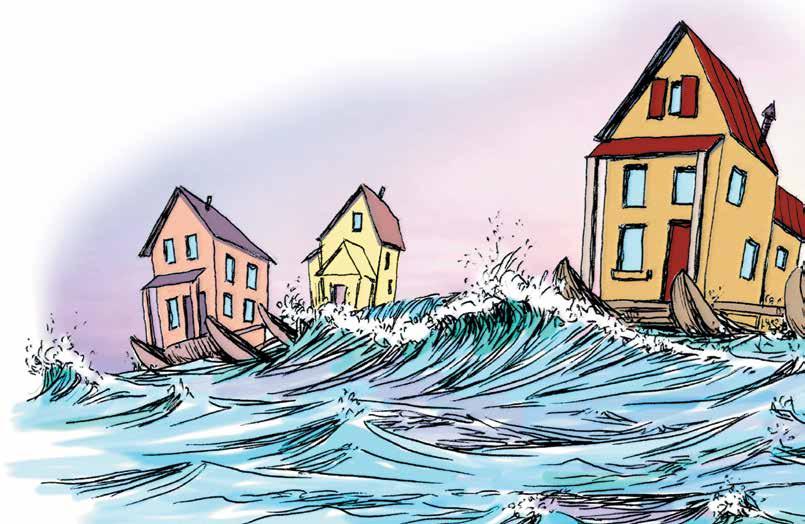
And in North Carolina’s Congressional District 3, which includes the Outer Banks, roughly 12,604 homes worth $3 billion risk being chronically inundated, the report says, while “Nags Head and Hatteras together would have nearly 2,000 at-risk homes in this timeframe.”
In other words, for anyone who bought such a house in the past 5 years, its life expectancy might be less than the 30-year-
mortgage. And even if it’s unlikely to fall into the sea, a good chunk of its equity might still “float away.”
“In many seaside communities like Galveston and Nags Head, homes are physically elevated,” the report continues.


“However, even if living spaces stay dry, if the access roads, surrounding land, and key
about a foot between now and 2050, leading to even more flooding — especially during seasonal high tides and wind-driven tides — as higher water tables make it more difficult for soil to absorb tide and rain. Furthermore, warming seas and disrupted weather patterns promise more hazards, like intensified hurricanes.
record books with increases in both units (8%) and sales volume (42%).”
And while the county takes steps to help individual homeowners protect their properties — such as issuing grants to raise flooded houses or closing a portion of Seagull Street so Rodanthe’s Ocean Drive homeowners can move their homes westward — there’s no comprehensive policy to keep people from building or buying in harm’s way.
It’s too easy to blame greed or ignorance. According to Clark Twiddy, it’s more of a
mix of economic inertia and the reality of human nature.
Twiddy is the president of Corolla-based real estate business Twiddy & Company. He says it’s not that the Outer Banks community doesn’t recognize the risks of future flooding. It’s just that no one knows what to do about it, as they balance different drivers in the community — tourism, government, real estate — and try to manage long-term impacts relative to immediate concerns.
“Most of us manage things on a day-to-day basis — things that have a very tight cause and effect,” Twiddy says. “Asking us to

“We have these zoning laws that were adopted in some cases in the 60s and 70s,” Twiddy says. “And in fairness, I think the folks back then could not have imagined in their wildest dreams that the Outer Banks would become what it is today.”
Even so, Twiddy sees practical ways to approach the climate issue while not having to dive deep into policy swamps. For instance, broadening funding and regulatory support for time-honored measures like raising and moving structures above and back from surf and flood waters.
He also says government should work to develop incentives — tax credits, grants or low-interest loans — for private property owners and businesses to encourage green building and landscaping, erosion controls such as living shorelines, and stormwater and wastewater management.
tax fund and municipal district taxes. The county is also currently developing a comprehensive stormwater management master plan.
Creef — who recently accepted a position as government affairs director with the Outer Banks Association of Realtors, a group that advocates for the industry — also notes that Dare County benefits from North Carolina’s strong building codes and its relatively newer and mostly elevated housing stock.
can be left on beaches, seemingly without consequences. Moreover, instead of finding ways to limit the number of threatened homes in the future, policy and profitseeking are keeping more houses and infrastructure in harm’s way.
According to the National Resource Defense Council, “between 2010 and 2020, North Carolina allowed more than 9,000 houses to be built within high-risk zones.”
massive, record influx of new residents

State and federal governments have recently funded some programs, but he says they’re not yet evident on the Outer Banks.
Still, Donna Creef, the now-retired Dare County Planning Director who served 33 years in the planning department, says she’s seen the county make progress over the years in terms of addressing the impacts of beach erosion and sea level rise.

“I think that we recognize that we are very vulnerable,” Creef says. “I think that planning is occurring, [although] sometimes it seems to be piecemeal.”
After some initial controversy, Dare County and its beach communities successfully completed beach nourishment projects, funded by a combination of an occupancy
While Hurricane Ian inflicted “a heck of a storm surge” on the Gulf Coast, she says, it tragically aimed its fury at older houses, many at ground level, and storm-fragile mobile homes.
However, the fact that a recently purchased home can still be swallowed by the Atlantic during an average winter storm — instead of being removed ahead of time — reveals gaps in multiple laws, insurance requirements, and zoning rules that need to be updated to address erosion impacts.
Not only are people somehow allowed to buy and sell threatened properties — potentially putting the hazards and the burden of clean-up costs on taxpayers — but damaged and abandoned septic tanks
What’s missing, Twiddy says, is a regional long-term system that is a combination of government, non-profit and for-profit interests to help address these and other looming climate challenges. It will involve a lot of work, cooperation and money, he adds, and mortgage and insurance industries will have to do major adjustments in their business models.
Without protective measures, he warns, not only will individuals risk losing their largest investment, but the community’s tourism industry and its tax base could be devastated.
And yet, he also recognizes that the threat alone might not be enough. Considering the heavy lift politically and fiscally, he says, it might take another large disaster to spur any real action.
“It’s like the old joke about human nature — you can change when you see the light, or when you feel the heat,” Twiddy says. “And, as we know, going back thousands of years, people are much more inclined to change when we feel the heat as opposed to when we see the light.” — Catherine Kozak
“ THERE’S NO OVERALL POLICY TO KEEP PEOPLE FROM BUILDING OR BUYING IN HARM’S WAY.

The spring of 1988 was brutal. Back-toback April storms accelerated erosion along area beaches, especially the northern tip of Hatteras Island. Over 100 feet of sand was lost during the first tempest, while the second storm took out an additional 60 to 80 feet. It was a cruel double blow, threatening both the Oregon Inlet Coast Guard Station and the southern base of the Herbert C. Bonner Bridge. (The well at the Station was also breached, and the building later abandoned.)
North Carolina Department of Transportation representatives and members of the Oregon Inlet and Waterways Commission quickly gathered on-site to inspect the damage. Later that week, North Carolina Governor Jim Martin toured the scene along with a representative from the Secretary of the Interior’s office, DOT officials, and other local leaders. All immediately recognized what was at risk.
As George Wells, a state highway administrator, remarked: “If the point is gone, the bridge is fully exposed to the ocean.”


In August 1988, a DOT study suggested building a groin on the inlet’s south side to combat erosion — offering a surprisingly patient, 10-year window for construction. However, a couple of intense nor’easters in March 1989 prompted quicker action. Soon after, the Hardaway Company of Columbus, Georgia, was awarded a $9.4 million contract to build a 3100-foot groin — or jetty, as it would be known.
That October, heavy equipment began moving granite boulders into place. By March 1991, the work was complete. (A tragedy occurred in November 1990, when 21-year-old Samuel E. Grimmet of Kill Devil Hills was struck and killed by a 10-foot steel bucket that he was attempting to attach to a crane.)
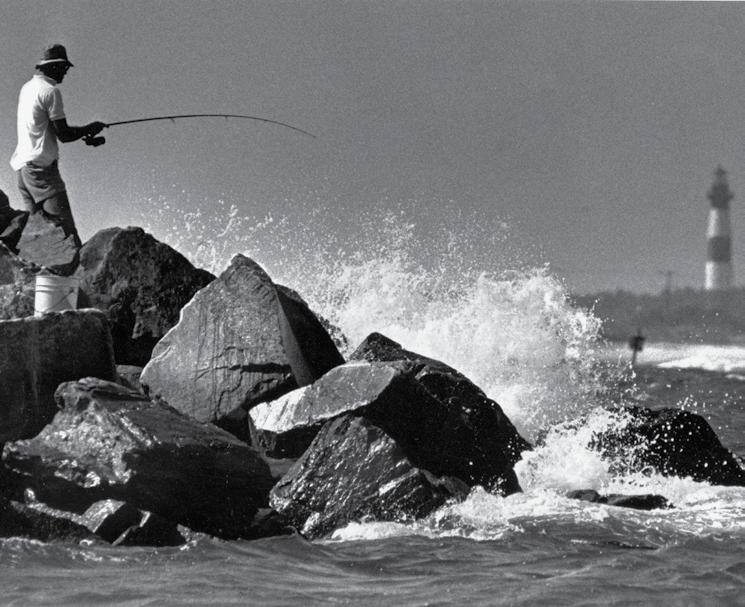
Oregon Inlet is a dynamic geological feature. And as the jetty slowly grew those 18 months, travelers across the Bonner Bridge marveled as sand began to fill in on the southern side.
The structure also provided a new angling experience — jetty fishing — and locals embraced the opportunity with gusto. They were immediately rewarded by a wide range of species swirling on the southern edge of the rock formation, including drum, trout, flounder, and bluefish. All were hungry and bit hard.
“I used to fish there the first couple of years it was built and catch all the Spanish mackerel I wanted,” remembers long-time Outer Banks resident Jack Joyce.


Joyce says his New Jersey roots drew him to the new jetty, which he often had to himself — at least at first.
“I don’t think too many people jetty fished,”
he recalls. “So, most times, I never even saw anybody fishing — some birdwatchers — but I didn’t see much in the way of fishing.”
Jetty fishing was not for the faint of heart. It required a long walk from the old Coast Guard Station road with gear in tow. The rocks were precarious and sometimes slick. Then, upon landing a fish, finesse came into play as to how you would land it. Many a fish were lost if they weren’t carefully walked to the sand.
As Joyce testifies: “I’m not one to cast large heavers with large pieces of bait, but the guys who loved drum fishing walked the fish a long ways to land it on the beach.”
For a time, even the mighty Atlantic had a hard time reaching the beach. The water on the south side of the jetty pooled up and became slick. Some days, schools of nicesized speckled trout swam back and forth, taunting eager anglers who looked on from the rocks.
However, the water was so clear and calm, the fish frightened easily. A bottom rig cast sent them fleeing. So that was out. Even a lead head whizzing over the water would cause a school to spook and scatter.
Eventually, some enterprising person figured out that the trout might hit a piece of bait dangling from a bobber — but lo and behold, a bobber scared the fish, too. With raw, unbridled Outer Banks stickto-itiveness, another creative thinker then came up with an idea to make a bobber or float out of something much smaller and lighter — a cigarette butt. And it worked!
But those times were short-lived. Gradually, sand built up and covered up the ephemeral angling oasis. However, for those who experienced its magic, the memories remain strong as ever. In fact, local musician and fishing guide Ed Tupper was only in elementary school when his father, Rick, took him to the jetty on childhood adventures. Thirty years later, he says he’s still never seen anything like it.
“Right where the jetty turned, the water flowed through the rocks and made this huge pond on the beach side,” Tupper marvels. “And it seemed like, every cast, you’d catch a different species of fish. Eight different casts, you’d get eight different species. It was the craziest thing ever.”
— Sarah Downing
Sources: “Groin Contract Awarded, But Hassle Still Alive,” Coastland Times, Aug. 5, 1989; “Response to Accident at Oregon Inlet,” Coastland Times, Nov. 4. 1990; “State Officials Amazed at Erosion,” Coastland Times, April 14,1988; “State Plans Breakwater Construction,” The Daily Tar Heel, Mar. 22, 1989.

“EVERY CAST YOU’D CATCH A DIFFERENT SPECIES.”
Warning all rebel felines — and owners of roaming kitties! The OBX SPCA, Coastal Humane society, and other non-profits are joining forces this offseason to manage feral populations. Operation Homeless Cat will be setting traps near groceries, restaurants and other favorite food sources. Any rogue residents they capture will be neutered and released back into their hoods, leading to a long-term fix for overcrowding at local shelters. Call 252-475-5620 to find out their plans, so your favorite Tom don’t get caught in the sting.
There’s booms — and then there’s BOOMS! This year saw a string of earthshattering expenditure figures, as we learned Dare County visitor spending hit $1.8 billion in 2021 — 30 percent more
than 2020 — only to find out in Sept. that we were up another 13 percent in ’22, with a record $200 million in the month of July alone. Experts are already noting that some of this year’s spike is due to inflation. But no amount of soft-selling can cushion the fact that a tectonic change is rattling our daily lives. (And perhaps even threatening our very foundation.)


Step aside, Pizzagate. We have an even stupider scandal. In Sept., a mob of Nags Head historic district non-residents and newbies came gunning for a nearby pizza place, even though the restaurant’s operation was completely legit and zoned commercial. So, what were the complaints? Vandalism? Theft? Nope. Basically, a bunch of Rich Person Problems that range from the ridiculously petty (“We don’t want to be looking at people chewing their food.”) to insanely paranoid (“It’s only a matter of time before they jump in our

pool.”). Even soon-to-be-former US Senator — and so-called fan of small business and limited government — Richard Burr, asked the town to “roll back” the pizzeria’s permit to take-out only. Luckily, no action was taken — except by the online community — which proceeded to chew the arrogant homeowners to pieces.
Sorry if we sound deflated. But S-Turns/SCurves used to be our favorite stretch of surfing pavement. In fact, for more than a decade, it was the Outer Banks’ ultimate “star bar,” the site of countless stoke-filled sessions. (Not to mention, the occasional guilty pleasure of seeing a packed sedan from Virginia get stuck chassis deep.) Sadly, that’s all come to an end since the DOT began ripping out the road in Oct. From now on, you’ll have to find somewhere else on Pea Island to pull over and get pitted — or huff-and-puff in to find your own secret peak. (Sssshh.)
cheering, jeering look at recent events and their potential impacts.
“Over my dead body!” That seemed to be the sentiment at Duck’s Oct. meeting, as the anti-beach-access brigade was back in force. This time, they were fighting plans to add an ORV route near Barrier Island Station for beach nourishment work. Once the project is complete, it would stay open for emergency vehicles and lifeguards, as well as the resort’s private homeowners. But neighboring residents still fought the idea, fearing that any corridor would eventually “morph into public access.” Because, in Duck, the only thing worse than watching a neighbor needlessly drown is seeing a stranger come over the dune.
What happens when you plop a cuttingedge wave pool in a surfing/skateboarding fertile crescent? You get a bumper crop of boardsports hustlers from the fields of Currituck! That’s the lesson from this


Oct.’s World Flowboarding Championship, where H2OBX Waterpark’s resident pack of performers — the OBX Flowgang — came home from Texas with 11 trophies, including James Boice’s first place in Junior Flowboard. (Not bad for some dudes from the sticks.)

We’re big believers in “inclusivity” of every stripe. So, we were pumped this fall to see our board of education take steps to allow for local homeschoolers to compete in team sports, as well as other extracurricular activities like drama and music. Apparently, statewide, only nine counties have a policy that lets unenrolled kids benefit from their districts’ after school programs — while 15 say no and 91 remain undecided. By Jan., Dare hopes to improve those stats to 10-15-90 and give every local parent something new to cheer for.
“Mork calling arson…come in, arson….” Sorry. Horrible joke. We just don’t know how else to handle the news that Frisco’s famous UFO-styled “Futuro house” is no longer with us. After all, for 50 years, this iconic structure was a symbol of the Outer Banks’ quirky, DIY spirit. And while we don’t know what caused the fire, seeing the one-of-kind landmark go up in flames feels like a tragic metaphor for our times… Hey! Maybe the aliens set their home ablaze and boarded a brand-new spaceship to some distant planet — a place where people still love sharing the beach. Where eating pizza in public isn’t a reason to call the cops. If so, all we can say is, “Come back! Take us with you!”
For detailed reports on these stories and breaking local news on a daily basis — plus plenty of local discussion — visit www.outerbanksvoice.com, www. islandfreepress.org, www.obxtoday.com, and www. thecoastlandtimes.com
“Thank goodness a US Senator is working on the important issues of our nation.”
— Grateful, “A Pizzeria Stirs Up Neighbors in Nags Head,” OuterBanksVoice.com, Sept. 21, 2022
We got questions — you got answers.
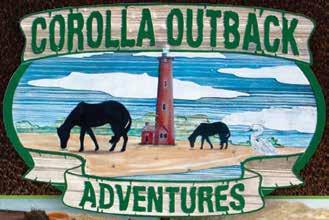


“It depends on the time of year. My family is set up for cold weather camping, so we could probably make it a while during fall. Plus, we have a big fluffy dog to keep us warm.”
“I could probably make it a week, as long as it wasn’t too cold. I grew up without A/C, so that’s not an issue. Actually, some of my favorite memories are playing board games by kerosene light when we lost power from storms.”






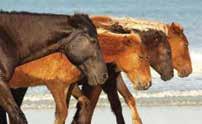



“I wouldn’t last long. I’m pretty bougie. [Laughs] Plus, we’re on well water, so not being able to take a good shower would definitely be the hardest part.”
“I could only last as long as my phone charge. The only way I can contact my family is by phone; I don’t think I could handle being disconnected for long.”


“I could make it about two weeks. If we are talking about something like Ian in Florida, the only thing I’d really be worried about is access to clean water.”



Mikaela
Corolla
“Three days. I’m a wimp. I need it to be a constant 68 degrees when I’m sleeping or else I can’t deal with it.”

“I just recently moved down from Detroit, and it seems like everyone here is really prepped. Where I’m living now is set up for seven days without power, with generators, fuel, et cetera, so I know I’m good for that long at least.”

Gavin Williams, 19


Colington
“I hate technology, and I hate having to respond to people on this stupid phone. So I wouldn’t need the power on for a long, long time.”


Identify this holy relic — hit the ropes at First Flight Adventure Park!


We’re raising the bar with this month’s puzzler. What protects the feet— but kills the liver? Is full of holes — but still handles gallons of liquid? And every 12 steps it takes, someone new falls off the wagon.
Think you’ve stumbled onto the right answer? Send your best guess — along with your name and phone number — to editor@ outerbanksmilepost.com by Jan 15. We’ll swirl all the right shots in a snifter and pick one winner, who’ll receive five night climbing passes from First Flight Adventure Park!
(PS. Congrats to Lisbeth Corado for winning last rag’s brain teaser: a ceiling fan shadow.)

Acorns. Caterpillars. Even shorebirds. A winter forecast may be resting right at your feet.
FORGET YOUR FANCY SMARTPHONES. Your super dopplers and GOES satellites. Jim Cantores and Jeff Masterses. In an age where the best science sometimes biffs — where even a five-day forecast is flawed and a 10-day prediction is totally worthless — you might as well go back to humankind’s earliest roots of meteorological prognostication: scanning the natural world for factors that seem somehow related, then making a semi-educated guess about the weather to come. Luckily, American culture is rife with wives’ tales and urban legends designed to foretell winter conditions via animal and plant behavior. Correlation may not be causation — but it’s sure entertaining.





Every winter you see “woolly worm” caterpillars crossing the roads, as they seek shelter to hibernate for winter. Many won’t make it. But look close at the ones that do, as each specimen’s furry sweater can help size up the coming season in a highly specific fashion — all based around their little black-and-brown bands. According to New England folklore — and Weather.gov — “The longer the woolly worm’s black bands, the more severe the winter will be. Similarly, a wider brown band is associated with a milder winter.” Furthermore, “The position of the longest dark bands supposedly indicates which part of winter will be coldest or hardest. If the head end of the caterpillar is dark, the beginning of winter will be severe.” Or, for a more local forecast, head to Banner Elk, NC, where October’s annual Woolly Worm Festival races the li’l buggers — then lets the winner’s color scheme predict the future by assigning a weekly forecast to the worm’s 13 sections. (The darker the color, the lower the temperatures.) Of course, biologists will tell you that color and fur thickness reflect the creature’s health and diet over its life, not any ensuing atmospheric conditions. But the folks in Banner Elk say different: “Scientists would prefer not to acknowledge it, but the woolly worm has an 80-85 percent accuracy rate for predicting the weather.” One thing we’ll guarantee? Come spring, they all turn into Isabella Tiger Moths. (Assuming they don’t get crushed between the curbs.)
On our sandy barrier island, the mighty live oak is beloved for providing cool shade by day, eerie silhouettes at night, and the ability to live for hundreds of years. But did you know they can also forecast the coming winter? Legend says the more acorns that drop to the ground, the harsher the season will be. The reality? Well, according to Ashevillewx.com, “Oak trees will produce a larger crop of acorns during wet years...and a wet year sometimes precedes a harsh winter.” And if that explanation sounds a little haphazard, that’s because it is. In a report by CBS News, tree expert Roger Wrubel says that “from about two-to-five years, oak trees [will flood] the system with acorns...so it overwhelms any predators.” Since squirrels and other animals can’t eat them all, odds are more will grow to become mature trees. (Unless a developer gets to them first.)
But they’re not just killers of future trees. Squirrels can also be little Jim Cantores. (With more hair and better personalities, of course.) Just ask the Old Farmer’s Almanac, which empowers these roguish rodents with a range of meteorological skills, from predicting impending blizzards — “Squirrels gathering nuts in a flurry, Will cause snow to gather in a hurry” — to forecasting entire seasons. Building nests higher is another traditional indicator of harsher winters. None of this is necessarily supported by science, of course. In fact, experts say storing food is just good animal sense. And it’s more likely that squirrels choose homesites based on current conditions as opposed to long-term hazards. (Just like every other self-deluding coastal resident.)

Long maligned for their superkeen abilities to target a deep-fried potato — or a brand new shirt — seagulls apparently boast another magical superpower: they can smell a storm coming from miles away. According to WXresearch.org, “Seagulls have a tremendous internal barometer that can tell them when air pressure is shifting.” Whenever they sense foul weather, they’ll seek shelter on land — and even move far inland if a storm feels particularly nasty. As a result, sailors have long monitored gull behavior for impending gales. But their “weather eye” also sees beyond the average coastal low. In fact, Sciencing.com cites research that says, “Picking up on infrasonic pulses, seagulls around the world have flown inland a day or two before major earthquakes.” In other words: while seagulls may love a good fry — they really can’t stand a healthy shake.
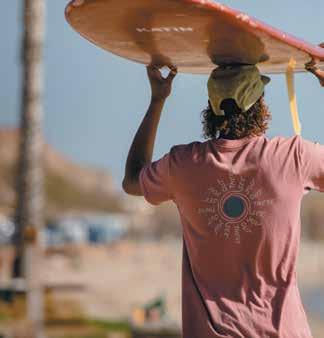
WOOLLY WORM HAS AN 80-85 PERCENT ACCURACY RATE.”


administrative assistant. The other 49 men and women fight fires for free.
“I think we are the biggest volunteer department in Dare County right now, possibly in eastern North Carolina,” says Bill Walker, department chief.

“Help! Help!” That’s not the sound of a person trapped inside a burning building. It’s Outer Banks firefighters, pleading for neighbors to come to their aid. In fact, this August, Dare County put out a video seeking volunteers. Why? Part of it’s a cultural trend in declining community involvement as job demands have increased (e.g., most bosses nowadays don’t let employees scoot out mid-shift to respond to a fire). But the larger issue is just simple math as the county deals with a record increase in both visitors and residents.
“More people [means] more calls for assistance,” says Steven Kovacs, Dare County’s fire marshal and deputy director of Emergency Management.
The issue is especially important when you consider how much the county relies on volunteers. Across our 15 districts, just one in five firefighters receives a check. In fact, in the case of Roanoke Island Volunteer Fire Department, the only paid staff are one mechanic and one part-time
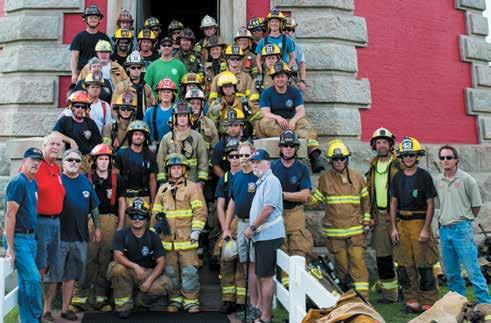
Walker credits his predecessor with launching a 5-year volunteer retention project, that he says “saves the community millions of dollars.”
Beyond providing fire, medical and storm recovery assistance, volunteers provide tangible financial benefits for residents. Without them, taxes would be higher to support a fully paid firefighting staff, and homeowner’s insurance rates would likely rise, too, Kovacs explains.
But volunteers clearly aren’t doing it for financial reasons. Their rewards range from finding camaraderie among fellow firefighters to helping people on their roughest days.
“You’re not calling 9-1-1 if everything’s

perfect,” notes Conner Roberts, a 19-yearold who has worked in the fire service for three years. “We get to intervene in a very intimate moment in someone else’s life; we are the people riding up to help someone.”
“And I really like driving the trucks,” he admits with a smile.
Roberts first volunteered with the fire service as a cadet in high school. He knew he didn’t want to attend a 4-year university, so he, his twin brother and a close friend went to an informational meeting at the suggestion of a family friend. They launched into an internship as cadets with Colington Volunteer Fire Department, simultaneously receiving high school credit and hands-on experience as they learned the ropes.
“I fell in love with it,” he says.
All three did. So much that they began taking classes at the Dare County Fire Academy — a program of non-credit courses through College of The Albemarle that ends with obtaining a state firefighting certification that allows graduates to be hired for paid positions. (Classes are free to individuals who are members of a fire department in North Carolina.)
Roberts has now been full-time with the Colington department for more than a year. His twin, Tyler, works with Dare County EMS but plans to volunteer as a firefighter in Colington again this winter.
According to Chief Glenn Rainey, the Colington station currently has four cadets, nine paid staff members, and 31 volunteers, with men and women ranging in age from 16 to 84. Rainey says about 70-80 percent of calls are medical in nature, which is close to the national average.
Career firefighters on duty respond to those calls to the station, which covers
the largest unincorporated portion of the county. But volunteer firefighters must pass the same annual “task-specific” testing as career firefighters, Rainey says, which includes dragging the hose, carrying equipment and raising a ladder. All active firefighters, whether career or volunteer, must also maintain a minimum of 36 hours of annual training.
Per state guidelines, cadets under 18 cannot go into a burning building, direct traffic or run certain equipment — but they still immensely benefit a station.
“They’re very eager and gung-ho and maybe that infuses the older firefighters, seeing the excitement that maybe they haven’t felt in a few years,” Rainey muses.
And the volunteers? The twins proclaim that no experience compares to firefighting. Tyler Roberts even finds the darkness in burning buildings peaceful, as he runs search missions using his hands as eyes.
“For me, it’s like you’re in your own little world,” he says. “Sometimes you can see your feet. Sometimes you can’t even see your hand in front of your face. It all depends on the fire conditions and how the smoke’s flowing inside the house. You always know your guys are either right in front of you or right behind you. That’s a really good feeling.”
But volunteers don’t only fight fires. Stations also need people to pass out water, bring snacks, organize fundraisers, raise awareness, and help in the office.
“If someone wants to volunteer, we can find a job for them,” Kovacs promises.
— Corinne SaundersFor more information or to volunteer, call your local fire district. Find contact info under the Fire Marshal’s page at www.darenc.com.
“
“MORE PEOPLE MEANS MORE CALLS FOR ASSISTANCE.”
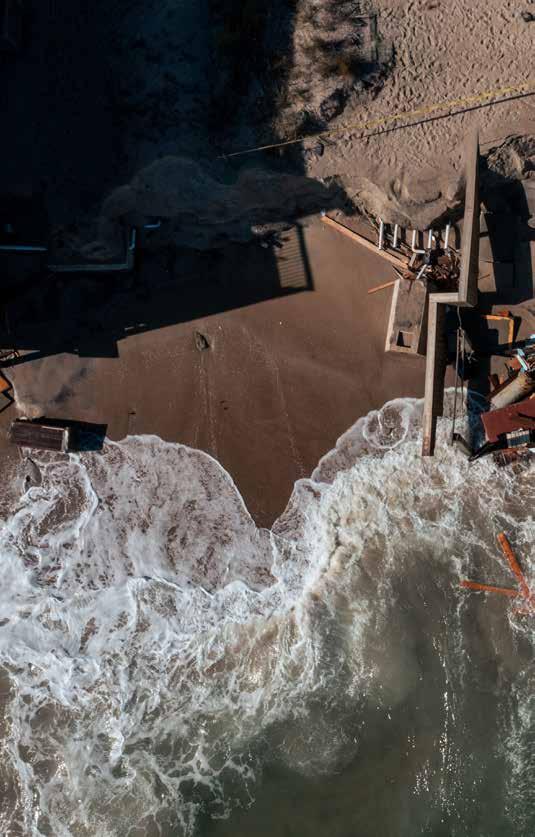






THEY SAY “ALL POLITICS IS LOCAL.” THE SAME GOES FOR WEATHER. For evidence, look no further than the average nor’easter. On the Outer Banks — where even smaller coastal lows can take out a house or close down a road — these winter systems are a constant cause for concern. But drive just a few miles inland, and they might not even merit a minute of worry.
“Here in the Carolinas, anyway, the impacts are right on the coast,” says Tim Armstrong, meteorologist and Climate Program Leader at Wilmington’s National Weather Service office. “My house is five miles inland, and I don’t really worry so much about nor’easters bringing any kind of damage.”
Considering the vast, unperturbed masses living between here and Asheville — not to mention further west — you start to realize why so little attention gets devoted to these frequent winter visitors. But just because mainland America might not sweat their impacts, that doesn’t mean coastal residents can rest any easier. In fact, as our populations get denser — and our planet’s climate grows warmer — more and more people will be forced to pay attention.
“Even if we don’t see any change in nor’easter strength and intensity compared to what we’ve seen in the past 50 to 100 years, the impacts from the storms will continue to increase because of rising sea levels,” says Armstrong. “So, you’ll have more coastal flooding — and more severe coastal flooding — affecting properties that were considered safe before.”

We asked Mr. Armstrong to explain how these storms work, and what makes them uniquely special to our strip of sand.

The Outer Banks’ relationship with nor’easters is more than just “complicated.” The National Weather Service’s Tim Armstrong explains why we just can’t shake these winter storms.All photos by Daniel Pullen



MILEPOST: Let’s start with the basics. What exactly is a nor’easter?

TIM ARMSTONG: Sure. A nor’easter is essentially a large area of low pressure that generally forms in the cooler half of the year — so October through April, or so — then takes an offshore track, and strengthens with strong gale force winds and so forth. And they’re called nor’easters because the wind direction is from the northeast.
Do they serve a function? I mean, we think of them as anything from a buzzkill to a catastrophe, but there has to be some benefit to them.
All storms feed on temperature contrasts. In a tropical storm, or even a pop-up thunderstorm in summertime, it’s a vertical temperature contrast. You have a lot of heat near the surface, and you have a lot of cold five or 10 miles in the sky, and that’s the temperature difference that fuels those storms. With nor’easters, it’s a horizontal temperature contrast across the earth. It’s heat out over the ocean or down to the south — Florida and offshore of the Carolinas — contrasting with cooler air over land or moving down from the north. And they’re trying to mix those two masses of air together. And that’s the purpose of a nor’easter, or any storm system anywhere on the planet: to try to even out temperature contrasts.
That’s interesting. It’s regulation; bringing balance back to some degree.
Trying to. And it’s a never-ending scenario. Because, if you think about it: how is energy deposited on the earth? It’s from the sun. And closer to the equator is always going to get more energy than areas near the poles. So you’re always going to have that temperature contrast reinforced every day that the sun’s out. You’re always going to have storms trying to undo what the sun is doing every day.
So how do nor’easters compare to hurricanes in terms of wind speed and air pressure?
If you put a barometer in the center of a strong nor’easter, you’re going to get a central pressure reading that’s down to say 985mb. That would be a strong tropical storm. Possibly even a weak Category 1 hurricane.
But in a hurricane, the winds are very, very concentrated in the center. With nor’easters, the impacts are spread out over a much, much larger geographic area.
For example, Hurricane Hugo, one of the biggest storms in my experience, was about the size of South Carolina. But a big nor’easter can be producing strong thunderstorms and tornadoes in Florida and at the same time be producing snow and almost hurricane force winds across the Mid-Atlantic and southern parts of New England. So, they cover huge, huge swaths of real estate. Much larger than any hurricane would.
amount of rain they can drop can be similar to a hurricane; I’ve seen reports of 6 to 8 inches of rain.
Wow. And yet it seems like they get less attention. Is that because they’re more common? Or because they produce less damage overall? Or…?
Well, they are more common. But the impacts of a nor’easter are usually right on the coast — here in the Carolinas anyway. Once you get to the MidAtlantic and Northeast, where there can be heavy snow, the impacts can reach hundreds of miles inland, and a nor’easter can drop feet of snow for the cities up in New England. But even here in Wilmington, unless you’re out there in a boat, or right on the beach itself, you just see it as a typical wintertime storm, bringing rain, cloudy skies, some breezy winds.
They last longer, too, correct?
Yes. It can sometimes be a couple of days before a nor’easter moves far enough away to remove its impact. Hurricanes — because they are geographically small — can fit into a single weather shift. Hurricane Isaias was literally a 6- to-8-hour storm, from first impact to last impact.
In terms of impacts, a strong nor’easter can very easily produce the same impacts you would see with a Category 1 hurricane. Wind speeds of 75 mph; 80 mph gusts. But because the winds affect such large areas of ocean, you can have fully developed seas. Even shallow coastal waters here can be 15-plus feet; out over deeper ocean water, near and east of the Gulf Stream, it would not surprise me at all if there are reliable reports of 40- to 50-foot seas during a powerful nor’easter. And the
Of course, on the Outer Banks, I’m sure you have a different perspective being such a marine-influenced area, because it’s when you get those large, large swaths of wind that give you very, very large seas and beach erosion that will last for days. The Outer Banks is also going to have the most impacts of any place in North Carolina, because you stick farther out to the east, and you’re surrounded by water. There’s an idea we have when we measure winds: marine exposure versus land exposure. Marine exposure is what you would have on the Outer Banks with the sound to your west and the ocean to the east. So, there’s no friction to slow winds down, like trees and buildings, like you have on land. So, you attain higher wind velocities there than anywhere on land in the Carolinas.
What’s the average number of nor’easters per year?
I don’t have a climatological number. We keep very good stats on hurricanes — for example, I can tell you the averages for tropical storms, hurricanes and major hurricanes. I don’t know that I’ve run across a statistic before about the average number of nor’easters or East Coast storms. For us, at the latitude of the Carolinas, I’m guessing that over a course of a winter season, we may have on the order of two dozen low pressure systems that go up the coast. Maybe only a couple of which would really earn the name of “nor’easter,” with those
“Nor’easters cover huge, huge swaths of real estate. Much larger than any hurricane would.”

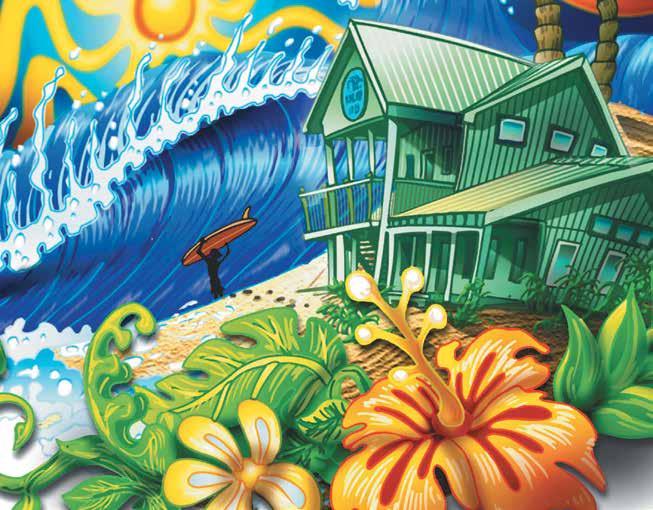
powerful impacts in terms of gale force winds and beach erosion and so forth. That number would increase as you went north up the coast.
Does that make nor’easters easier to forecast than a hurricane? Or is it harder?
Our models do seem to handle nor’easters better. Also, with a hurricane, there is a very narrow swath of intense winds near the eye. So, if your forecast is off by 30 or 40 miles, you may have completely messed up your forecast in terms of wind directions and impacts on a certain city. With a nor’easter, sometimes hundreds of miles horizontally at a time will have pretty much the same weather — 30 to 50 mph winds, heavy rain and so forth — so they’re easier to forecast in that regard.
How is climate change affecting nor’easters? Is there more frequency? Intensity? All of the above? And why?
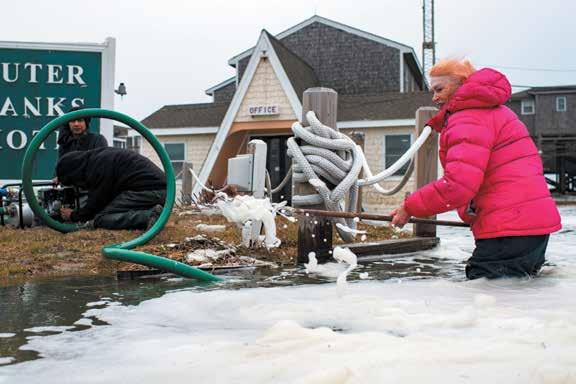
Well, I’ve only found a couple of papers that have been published on this subject, and the evidence for this is not easy to tease out of the data. Because, essentially, there are two competing factors at work. I mentioned earlier how a nor’easter’s purpose in life is to form in areas of strong, horizontal temperature contrast across hundreds of miles of land or ocean. As climate change continues through this century, the poles are actually warming faster than the equator. So, on a global scale, you could see the number and intensity of these non-tropical storms decrease, because there’s just less temperature contrast around to fuel them. However, there is a local effect here on the East Coast of the US, mentioned in one paper, where the subtropical ridge — we call it the Bermuda High in the summertime — could actually extend farther north, both in summer and wintertime. And that could lead to an intensification of that temperature gradient right along the Mid-Atlantic coast of the US, which could — at least from the Carolinas to the Mid-Atlantic — actually breed an increase and a strengthening of nor’easters.
And it doesn’t matter if there’s fewer nor’easters elsewhere, right? If you’re getting hit harder where you are, that’s really the issue. Yeah. And it’s the really intense storms that produce the tremendous amounts of damage that leave their mark. You’re gonna forget the 20 weak nor’easters or weak non-tropical systems, as long as that one produces tremendous impacts.
Another change that’s happened with hurricanes is the rapid intensification prior to landfall. And that has to do with sea surface temperatures. Anything similar going on with nor’easters? Or is there potential?
Not anything that I’ve read yet. But it’s certainly been well documented with satellite and observational evidence that, at the core of some of these nor’easters, especially when they’re right on the edge of the Gulf Stream where the temperature contrasts are really powerful, that they can spin up a really tight core that almost looks tropical-like. It’s not, but you’ll get very, very strong winds right
are “our” storms, compared to parts inland — or even compared to Wilmington.
And you can certainly own those storms when you live on the Outer Banks. You’re going to be the one part of North Carolina that’s getting absolutely reamed by a storm, where Raleigh and the inland cities are wondering, “What’s the big deal?’ Because they got a little bit of rain out of it.
But, certainly, the coastal impacts are really significant, so there probably should be more research directed at it. I know one research project that still gets talked about is the GALE Project (Genesis of Atlantic Lows Experiment.) In the 1980s, they ran lots of research flights, launched extra upper air balloons to collect data, and set up special research radars along the coast. And they were essentially trying to figure out what makes these storms really explode once they get off the edge of the Carolinas. Some of the data indicated the role that strong temperature contrasts play in these storms during the wintertime.
around a center that’s technically an eye. But I’m not sure how the frequency or intensity of that has changed with climate change.
So, that’s the other thing that blows my mind. There’s only been two papers on this? You think of the time and energy that’s been focused on hurricanes or wildfires or droughts or sunny day flooding. Are nor’easters just not as sexy as hurricanes?
Well, Hurricane Florence was killing people with flooding over 100 miles inland from the beaches. There were damaging winds of 100 mph many miles inland from the beaches producing widespread devastation. In terms of the potential to affect a lot of people that aren’t just on the coastal strip, I think hurricanes check all the boxes. Where here, in the Carolinas anyway, the impacts are offshore or right on that coastal strip.
That’s interesting. It might explain why, culturally speaking, we on the Outer Banks have such a strong connection with nor’easters. They really
Particularly when you have a cold arctic air mass push out over the Gulf Stream and you get those really intense mixes of air masses — air that’s maybe 20-25 degrees pushing off the beaches, and, within a couple of hours, is out over 78-degree water in the Gulf Stream. The crazy things that the atmosphere does when there’s that much temperature contrast going on in such a small area can really drive these storms to intensify very, very rapidly. In fact, the project showed that, when arctic air encountered the Gulf Stream off the Carolinas, the rate of energy transfer was roughly equal to what you’d see during a Category 1 hurricane.
Crazy. Apparently, North Carolina State University is using former WWII spy planes to forecast snowstorms. Have you seen this?
I haven’t. But the data it collects will certainly be helpful. Getting profiles of pressure, temperature and winds inside a developing nor’easter will help out forecasts in real-time. Perhaps even more importantly, the data will help improve our understanding of how these storms develop and strengthen.
Have you ever seen an evacuation for a nor’easter?
I’ve never seen an evacuation for a nor’easter in my experience. But I should preface that by saying
“When they’re right on the edge of the Gulf Stream, some nor’easters can spin up a really tight core that almost looks tropical.”



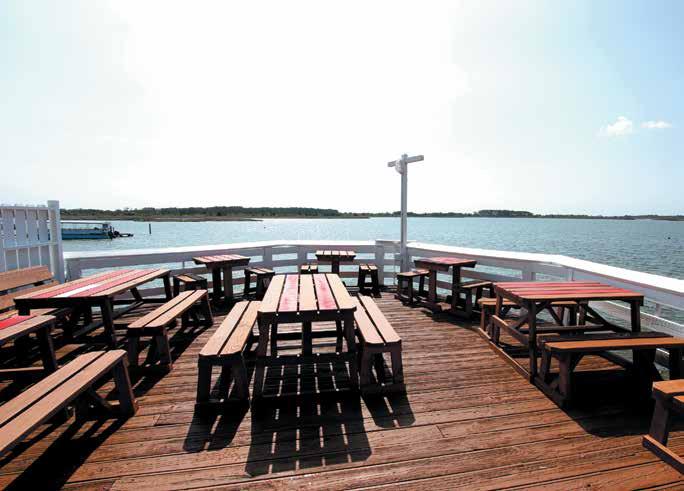


that evacuations aren’t anything that the Weather Service does. We certainly brief emergency management, then it’s up to those officials to make the calls. But I could easily see that, if you had a powerful nor’easter that occurred at a spring tide, for example, where the astronomical tide levels are already going to be high, you could have enough flooding, potentially, that would drive evacuations. I have not seen that in my time here, but it would not surprise me if that would be the case at some point in the future.
What other elements might lead to an evacuation?
Obviously advancing sea level rise is one. Even when there’s not a storm going on, the ocean’s going to be a little bit higher. And, unfortunately, you’ve got areas that never would have received significant coastal flooding experiencing big impacts from that. So, I can see that in the future, as several of these factors continue to increase in tandem, coastal flooding impacts could possibly drive evacuations in the future.
This might be asking a lot, but one thing that’s been said is, whether it’s floods or droughts or wildfire, 100-year events aren’t 100-year events anymore. Are nor’easters in that same category?
It’s difficult to stay in terms of the number and intensity yet. There’s that one research paper I referenced that says we may see a local increase in the intensity and the number of nor’easters on the MidAtlantic coast. We haven’t really seen that anecdotally, here, just yet. And when we talk about a “once-in-a-100year storm,” that means it has a one percent annual chance of occurring. And whether it was last year or 100 years ago, it doesn’t mean that this is the year that it happens.
But the background percentage chance may be increasing in terms of number and intensity. And, certainly the impacts of the storm, coastal flooding and rainfall will be rising as time goes on. So, even if we don’t see any change in nor’easter strength and intensity compared to what we’ve seen in the past 50 to 100 years, the impacts from the storms will continue to increase because of rising sea levels — so you’ll have more coastal flooding, and more severe coastal flooding, affecting properties that were considered safe before. And you’re
going to have an increase in the amount of rainfall. A nor’easter that tracks close to the coast can produce locally heavy rainfall. And that should become more and more of a threat as climate change continues through this century and beyond. So even if that one research paper is wrong, and we continue to see base level activity, the impacts from the storms will continue to increase through time.
Is population the real x-factor as we face climate change moving forward? So many more people are living in areas that are affected by floods or wildfires or storms.
That’s certainly an aspect to it. More people live in more at-risk areas than they did 100 years ago. That’s true. But it’s also true that climate change is producing impacts in areas that never saw them before, whether people were there or not. The amount of beach erosion we see here in association with nor’easters or hurricanes is worse now because the ocean is eight inches higher than it was 70 years ago. Because the air is warmer now, it holds more water. And so the same thunderstorm that held an inch of rain 100 years ago, now drops an inch and a quarter. So, all your statistics are changing because of climate change, in terms of coastal flooding, in terms of the amount of rain storms drop, and so on.
That’s the first time I‘ve ever heard that number: eight inches in 70 years?
That’s correct. We’ve had a tide gauge in Myrtle Beach since the 50s, and it’s recorded eight inches of sea level rise. That number’s going to change
from station to station up and down the coast, but for most of the East Coast of the US, it’s about eight inches of sea level rise. And that number is predicted to not just continue to rise, but to accelerate its rise at a faster rate through this century.

I keep wondering what an Ash Wednesday storm would do here today. Back then, Dare County had roughly 6,000 people. Now it’s more than 36,000. And a lot more houses.
That’s hard to say. But go look at the Ash Wednesday tide benchmarks and add eight inches to that. Find what your rainfall totals were and multiply that by another 10 to 15 percent. Even if there’s no change of windspeed or track, the impacts from those factors alone will certainly be higher than what we had in 1962.
And it’s funny, too. Humans aren’t thinking about the fact that it’s not just the weather changing; our understanding of the weather has changed. So what might have worked before might not work in the future.
That is one possibility. But, certainly the capability for monitoring Earth, with satellites and buoys and super computers to model what is going on and trying to predict the future is increasing by leaps and bounds. So I have no doubt whatsoever that we will surmount any sort of temporary setbacks and learn how to forecast this stuff better and better every day.
Any warnings, affirmations— anything to say to people as they consider this information?
Well, in the near term, the Weather Service’s focus is on the next seven days. But we provide forecasts beyond that from our national centers. The weather prediction center in DC will send out two-, three- and four-week outlooks showing areas that are expected to have above or below normal precipitation. So, pay attention to the weather. Just because it’s not tropical season during the wintertime, it is nor’easter season. So, stay tuned to your local and national weather service for updates on developing storms that you see.
Guess that’s all you can do, right? You can’t control the weather — but you can control your response.
Absolutely. Always make sure you’re prepared. The
clarity and flow. Find
www.outerbanksmilepost.com.
“Even if we don’t see any change in nor’easter strength and intensity, the impacts from the storms will continue to increase.”









NOT EVERY STORM COMES WITH A MONIKER, BUT THAT DOESN’T MAKE THEM ANY LESS MEMORABLE. HERE’S A LOOK BACK AT FIVE BRUTAL SYSTEMS THAT LEFT AN IMPRESSION SO MASSIVE, THEY REMAIN UNFORGETTABLE.




FOR BUSTER NUNEMAKER, MARCH 7, 1962 BEGAN LIKE ANY OTHER WINTER WEDNESDAY. He got dressed. Ate breakfast. By 7:30am, the 12-year-old Nags Header was walking toward his Beach Road bus stop near Milepost 10. But he only made it a few steps before stopping in his tracks.
It was the slow build-up that likely lulled locals into a false sense of security. What seemed like only a particularly persistent winter blow morphed into all hell busting loose in the wee hours of the night, while most everyone still lay asleep.
“As I came around the north end of my house, the water was already up to my knees,” the 73-year-old recalls. “I went back and told my mom and dad, ‘I don’t think we’ll be going to school today.’”
That would prove to be the meteorological understatement of the century. By noon, there was three feet of seawater in the family’s house, and Buster’s dad was pushing him through the bathroom window and onto his Uncle Charles’ juniper skiff. They motored to the relative safety of his grandmother’s home, which sat five feet higher. But, by 8:30pm, the water was creeping though her floorboards, too, and they were all fleeing toward Colington in dark, wintery conditions.
“It was sleeting, it was snowing, the wind was blowing 35 to 40,” Buster says. “I mean, it was a scary thing for a 12-year-old to not know what’s happening other than everything was flooded.”
Dawn would reveal historic levels of destruction. According to March 9’s The Coastland Times, “the entire beach north to Kitty Hawk [had been] submerged in water varying from one to six feet in depth.” Wind observations in Nags Head had reached “up to 76 miles per hour.” Waves were reported “in excess of 20 feet high.” Jennette’s Pier and Nags Head Pier were “completely lost.” Kitty Hawk and Avalon piers were “crippled,” and “scores of cottages [were] splintered, washed to sea.” New inlets and buckled roads made travel “virtually impossible.” Residents remained without power or any means of communication.
At the time, the paper estimated local damages at $10 million — $93 million in 2022 dollars. And while our own Aycock Brown gets credit for naming the system, its impacts traveled well beyond. According to the National Weather Service, between inland blizzards and coastal flooding, the storm killed 40 people, injured thousands and “caused over $200 million (1962 dollars) in property damage…from North Carolina to Long Island, New York.”
Sixty years later, the US Geological Survey still calls it the “the largest East Coast winter storm in terms of land loss and number of homes damaged or destroyed,” a once-in-a-lifetime combination of three systems that “remained stationary for almost 36 hours so that beach and barrier flooding lasted over five consecutive spring high tides.”
Pat Preston reckons it was 6am when his family awoke to two feet of water in their cottage, which sat near where Nags Head’s Surfside Plaza stands today. All five climbed to an upper porch. When a Coast Guard chopper proved unable to rescue them, they hunkered down and watched the ocean do its worst.

“I saw old Nags Head houses floating down the beach road like boats,” he says. “Once the waves knock a dune down flat, it’s like microwaving some butter; it just disappears.”
The water, however, does not. Each crashing wave added thousands of gallons. Much of it pooled up against the newly built bypass, flooding everything back to the ocean. In places where the pressure proved too great, pavement buckled and new cut-throughs appeared.
down in his grandmother’s house, his father and uncle spent the day in an airboat, racing as far north as Kitty Hawk to help their neighbors. Ultimately, the duo would receive Coast Guard commendations for rescuing 40 people.
“They took them to the Colington intersection,” Buster recalls, “where the Red Cross, the police, and family members were waiting for news of friends and relatives.”
In the following week’s paper, all residents were accounted for. Furthermore, despite the freezing air and water temps, there were only six injuries reported and no direct fatalities. But the recovery was clearly just beginning. Repairing the “worst in history” road damage would require 100-plus vehicles, several hundred men and — ultimately — a wooden bridge to span the 200-foot inlet that was cut north of Buxton. (Surprisingly, Hatteras Island was mostly spared otherwise.)
Meanwhile, in town, the Red Cross began dispensing care in the local schools. A nurse was inoculating residents against typhoid and lock jaw. The SBA was onsite to advise all the businesses who’d lost nearly everything. As residents piled up belongings to dry near the bypass, officials put up check points to prevent looting. But it would be several weeks before all the sand and water disappeared. And still longer before they got power or potable water, as every residence still had a well.
“They had water tanks about every six miles,” says Pat. “We didn’t have any plastic, but every third day or so you’d grab whatever bottle or pan you could find and go gather up all the water. And that’s when they took out bonds to build a water plant, right after the Ash Wednesday Storm.”
“The water cut an inlet right by the Baptist church,” says Pat. “And it poured straight down Soundside Road. Every house had water in it. One family had to jump off their porch as the house was going down.”
Ironically, that same March 9 newspaper has a regular shipwreck column called “Men-and-the-Sea.” But it’s salty depiction of an 1894 schooner rescue pales to the news of the day, as hundreds were evacuated by military choppers and road maintenance equipment. In fact, Roanoke Island’s Ephey Priest personally brought 20 beachside residents back to Manteo — including the Prestons — by “braving strong winds through the day in his diesel road scraper.”
“I was nine, so they put me in the cab,” Pat says. “The others had to hang on to the cage like a bunch of spiders.”
Meanwhile, as young Buster Nunemaker hunkered
All told, Buster Nunemaker only missed a week of school. But he reckons it took “a good six months just to get some semblance of a feeling that everything was going to be okay.” And he still tears up remembering what his family went through.
“Everything we had was ruined,” he says. “I remember when they were taking all the floors out of the house. And my mother walked in and said, ‘If this ever happens again, I’ll never come back.’”
Fortunately, the Outer Banks has still never seen its like. It’s hard to imagine the impacts today, as we’ve grown from an isolated outpost of scattered cottages to a fully developed, bustling beach destination. But ask Buster, and he’ll tell you to consider the Mirlo Beach stretch where a minor nor’easter can bury cars in sand and pull a home off its pilings.
“Now magnify that by 50 times,” he says. “Maybe even 100 times? I don’t know. I just know it’s something I don’t ever want to go through again. And I surely don’t want others to go through it.” Matt Walker
“ONCE THE WAVES KNOCK A DUNE FLAT, IT’S LIKE MICROWAVING SOME BUTTER; IT JUST DISAPPEARS.”
IN ANY RECORD BOOKS. It’s a purely local term for a distinctly local storm. One that struck on March 7, 1989 — exactly 27 years after its namesake — then raged for days, leaving a whopping five million dollars in damage.

More importantly, it arrived in the late 80s, just as the Outer Banks’ year-round population was starting to boom and a solid 16 years after a ’73 system took down the Arlington hotel — giving many younger natives and fresh arrivals their first real taste of a nor-easter’s destructive potential. And while it may not have been a regional powerhouse, its impacts remain among the most lasting: in its wake, Dare County officials first began seriously considering the prospects of beach nourishment, as well as started immediate efforts to build a jetty at Oregon Inlet.
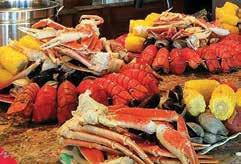
The storm was a doozy of a tempest. According to an article in American Scientist, “The strength of this single storm at North Carolina’s Outer Banks accounted for two-thirds of the yearly average wave power and sediment transport along the coast.”

By the second day — Wednesday, March 8 conditions intensified. Schools opened an hour late. Dare County representatives and officials
from Southern Shores, Kill Devil Hills, Kitty Hawk, and Nags Head met in an emergency meeting to declare a voluntary evacuation of “people in motels and cottages.”
Earlier that morning, county commissioners convened with Hatteras residents about the condition of the Bonner Bridge. County Emergency Manager George Spence warned, “There is a very great possibility of extreme oceanside flooding at high tide tonight.” Meanwhile, Gary Ferguson of the Nags Head planning department reported that, until conditions improved, little could be done.
“At this point, the tide is so high we can’t get out and survey the structures,” he said.
After the storm subsided, a bleak picture emerged. Old timey mom-and-pop hotels like the Claydon in Kill Devil Hills and the Pebble Beach and Sand Spur in Nags Head were no match for the 8- to 10-foot waves whipped up by winds that reached 58 miles per hour. Over 250 houses were “destroyed, damaged, or made uninhabitable.”
South Nags Head and Kitty Hawk were hardest hit; debris from the former washed up as far as Coquina Beach. Seventy-five feet of the Rodanthe Pier got swept away. A Kill Devil Hills woman
sustained head injuries after falling down a sand cliff. However, some residents and businesses seemed to take everything in stride. Station Six Restaurant, now the Black Pelican in Kitty Hawk, reported that it “survived another storm” and was pleased to announce its opening for the 1989 season the following week.
By Thursday, Mikey Daniels, chairman of the Dare County Board of Commissioners, commissioner Sonny Ambrose, and George Spence performed an aerial survey of the Dare Coast via helicopter to see the destruction from above. Daniels remarked that “the debris from the storm is incredible.” NCDOT engineers arrived to survey erosion at the southern terminus of the Herbert C. Bonner Bridge over Oregon Inlet. Also arriving to inspect the damage was Duke University’s Dr. Orrin Pilkey, an expert in coastal erosion.
Because another damaging high tide cycle was predicted, an emergency shelter was opened at Kitty Hawk School as a precaution.
The following week, on Monday, March 13, North Carolina Lieutenant Governor Jim Gardner and an entourage of North Carolina Department of Transportation officials toured the area via helicopter giving them a birds-eye view to witness the damage. Gardner reported to Governor Jim Martin that a terminal groin should be built to abate further erosion. He was serious too, recommending that the governor ask NCDOT to get permits and paperwork in order.
“We are not talking about a slapdash, inexpensive band-aid for the inlet with this terminal groin plan,” he said.



At the March 14 meeting of the Dare County
Sources: “Beach, Bridge Perils Discussed,” The Coastland Times, Mar. 9, 1989; “Storm Damage Estimated at $4 Million,” The Coastland Times, Mar. 12, 1989; Robert E. Davis and Robert Dolan, “Nor’easters,” American Scientist, Oct. 1993; Quillan, Martha, “Nor’easter Ravages Building on Dare Beaches,” News and Observer, March 10, 1989.


Board of Commissioners, commissioner Bobby Owens suggested that the county use a portion of its occupancy tax to fund a beach nourishment project. It was hoped that if Dare took the initiative, state and federal funds might also be tapped.
Although the shore was strewn with mangled lumber and nails, beachcomber Charles Englebert made a remarkable discovery at Oregon Inlet when he came across an intact balloon washed up amidst the storm debris. It had made its way to the Outer Banks after a school in Niagara Falls, New York, held a balloon release. (We know better


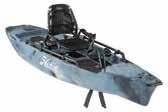
than to release air born pollutants now.)

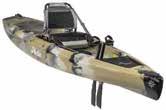
Today, Pilkey is “long since retired.” But for years, the former professor visited after every big blow, and he is still just as worried about the Outer Banks’ future. In fact, he points to last year’s November 7 storm as just cause for concern.
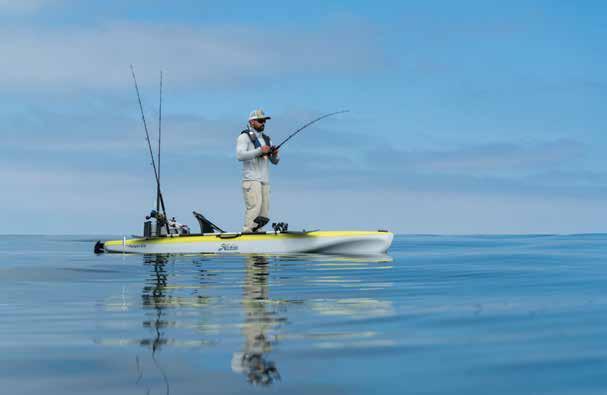

“There were two to three days when nobody could get on or off the island,” he says. “And that was a mild nor’easter. Add a little bit of sea level rise, and a little bit of expected intensification of storms, and you’re dead in the water — so to speak.” Sarah


 Downing
Downing
OVER 250 HOUSES WERE “DESTROYED, DAMAGED, OR MADE UNINHABITABLE.”
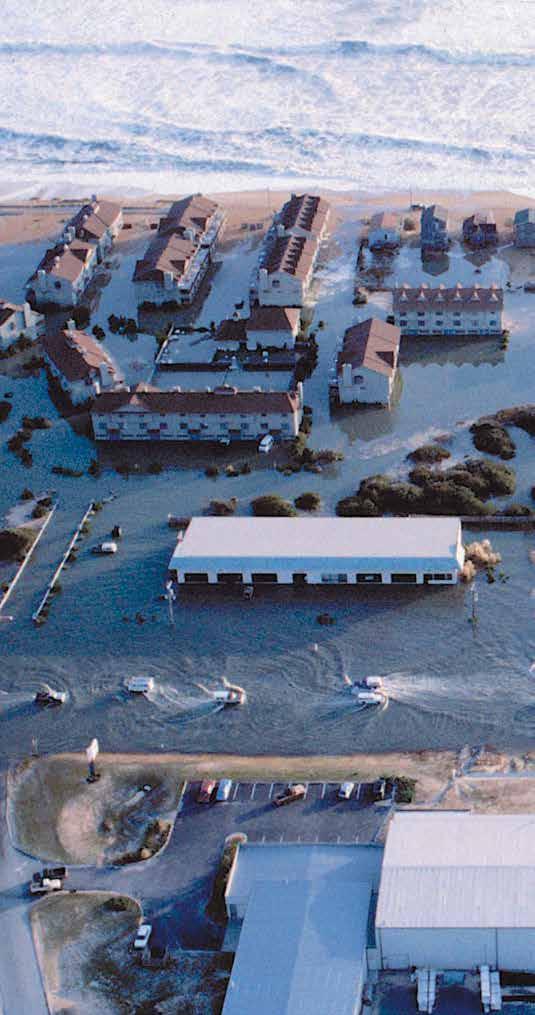



IT MATTERS NOT WHAT YOU CALL THIS METEOROLOGICAL MONSTER. The Halloween Storm. The Perfect Storm. For a brief period, it was even the “The No Name Storm.” What matters is that three distinct systems came together in late October
of ’91 to produce a weather event that, according to the National Weather Service, “was one of the longest continuous episodes of high seas, heavy surf, and flooding in North Carolina.” And that it left a path of catastrophe from here to New England.
It started as a low off Bermuda. On October 26, offshore buoys picked up increasing swells from the building subtropical system. The following day, the NWS began calling her Tropical Storm Grace. And when winds reached the obligatory 74 miles per hour, she was upgraded to a hurricane and expected to move towards the North Carolina coast.
The next ingredient was a strong high-pressure system over Canada. While it kept Grace at bay in the Atlantic, it brought a “backdoor” cold front into the state on October 28. That night, sustained gale force winds rattled the Outer Banks. The Army Corps of Engineers Research Station at Duck recorded waves of 12 feet.
According to the NWS event synopsis, northeast gusts from Grace’s circulation were then bolstered by “a strong pressure gradient associated with the high. Therefore, the rough seas and heavy surf continued to amplify as the high became the dominant forcing mechanism.”
This dogged high became the third element to complete the construction of “The Perfect Storm,” by way of becoming a North Atlantic Cyclone off the Canadian coast. All that remained of Hurricane Grace would combine with the new unnamed system on October 29.
Meanwhile, the Outer Banks kept feeling its impacts. The S-Curves in Rodanthe, always an indicator of storm severity, experienced extreme overwash. Elsewhere along NC 12, the ocean and sound converged, forcing drivers to abandon their vehicles and stranding visitors on Hatteras Island.
A group of 4th graders from Kitty Hawk Elementary School got an unexpected stay Down South following a field trip to the Frisco Native American Indian Museum. Twenty-six students and six adults had dinner at Cape Hatteras School (which had closed at 12:30pm that afternoon) and then spent the night at the Tower Circle
Motel. In the morning, groups were flown by Dawn Air from the Billy Mitchell Airport to the Kill Devil Hills landing strip near the Wright Brothers Memorial.
The following day, the northern beach towns were inundated with an ocean flood tide east of the US 158 bypass. Once more the road held back the water, like a dike.
The worst tide was the high tide of Thursday morning, October 31 at 3am. Saltwater collected on power lines causing 2,000 dwellings and businesses to lose power.
The storm brought no rain, just wind and tide, but that was enough to fill the bypass and surrounding parking lots.
In Kitty Hawk, the US 158 Bypass flooded at the Milepost 4 Shoppes. The Sea Dunes Condos suffered damage. Six oceanside structures “had the rear wall punched out and furniture pushed through the front, laying all around the property.” Two hundred properties had septic systems damaged.

In Nags Head, eight miles of protective dunes were lost, including in front of the Armada Inn —today’s Comfort Inn South. The heavy tide broke the windows on the first floor of the Sea Ranch in Kill Devil Hills. All the ground level rooms required repair.
Sandy Sanderson, Dare County’s head of emergency operations, still remembers a precarious situation that rose with the tide. While fighting a house fire on Cedar Island, just off the Nags Head-Manteo causeway, a firetruck with Nags Head Fire Chief Paul Royston aboard had a close call.
“I think we had three or four feet of water on the causeway that time,” Sanderson recalls. “And the water came up so fast we had to get them out of there before they were stranded — that took some doing.”
Dare County later estimated the damage topped $7 million. And the NWS says a “Heavy Surf Advisory was in effect for 5.5 days and a Coastal Flood Warning was in effect for 3.5 days.” And even though 33 structures were later condemned, Halloween went off with only a few rescheduled events and other minor glitches.
Coastal communities to the north fared worse.
New York and New Jersey saw the worst damage since the Great Atlantic Hurricane of 1944. In Maine and Massachusetts, hundreds of houses were damaged or destroyed, including President George H.W. Bush’s vacation home. And a total of 13 people died — including the crew of the Andrea Gail, a fishing boat lost in the North Atlantic. Their tragic fate would inspire the book and film, whose titles — The Perfect Storm — sealed this historic weather system’s name for the ages. —
Sarah DowningTHE HEAVY TIDE BROKE THE WINDOWS ON THE FIRST FLOOR OF THE SEA RANCH.Sources: “Sigh of Relief Breathed by All,” The Coastland Times, Nov. 3, 1991; “Waves Just Keep Coming, Dare Suffers Much Damage,” The Coastland Times, Nov. 3, 1991; Pelissier, Joseph (1991), “North Carolina Coastal Flood” (GIF); National Hurricane Center, accessed Sept. 11, 2022.
When it pounds you from the west.
Like most winter blows, 1993’s Storm of the Century formed when a warm air mass from the south clashed with cold artic air from the north. Unlike most winter blows, it turned into an exceptionally massive and powerful system. With a central pressure consistent with category 3 hurricanes, the beast spawned tornadoes, blizzards, dangerous cold, and coastal flooding from Florida to Nova Scotia.
Later classified as a superstorm, an extratropical cyclone and a nor’easter, the system affected nearly half of the U.S. population from March 12 to 14. But it never moved far enough east for the wind to turn onshore — at least in Dare County. Here, the 58- to 70-mile per hour winds all came from the west, punishing the soundside from Avon to Duck and, in places, pushing the water 7.5 feet above the high tide line — producing one of Dare County’s worst-ever flooding events on March 13.
According to reports in The Coastland Times, six barges working on the Wright Memorial Bridge were blown north, washing up toward Duck and Southern Shores. Two couples visiting Pea Island National Wildlife Refuge reportedly battled wind, rain and flooded roads all the way to Rodanthe, where they broke into an empty house for safety. And Island Convenience Store owner Mac Midgett said it was the highest water he’d seen in Rodanthe since 1944. Also in Rodanthe, the US Post Office burned to the ground when firefighters were unable to navigate the floodwaters.
“It was a honking blow, boy,” recalls Bill Rea today. “It was blowing so hard you could lean into the wind way past your balance point and not fall down.”
At the time, the Roanoke Island musician was captain of the Elizabeth II, which was at the shipyard in Manns Harbor for winter repairs. Around 2pm, Rea went to check on the vessel. Upon arrival, he and the dockmaster watched as three of its four dock lines gave way.
With winds swinging the 69-foot wooden vessel out into the creek, the dockmaster raced back to the building to get a forklift. Rea shimmied 15 to 20 feet along the remaining line and crawled aboard, and they used a second line and the forklift to secure the historic ship, then fled Manns Harbor as fast as possible.
Floodwaters were so high, Rea had to use the trees on either side of the road to find his way home, as water seeped in through the floorboards
of his truck. Only when he parked in the driveway did he realize how fortunate he was — and how foolish he’d been.
“When I got to the house, where I had a wife and infant inside, I just sat there,” Rea remembers. “I couldn’t get out of the truck. I thought, ‘What in the hell did you just do?!”
It wasn’t the only close call. Minta Meekins remembers going to check on Oregon Inlet Fishing Center and getting trapped with several others inside the unheated building. Flood waters crested the gas pumps, and three boats — including the Gannet and the Daredevil — got impaled by pilings and began sinking at the docks.
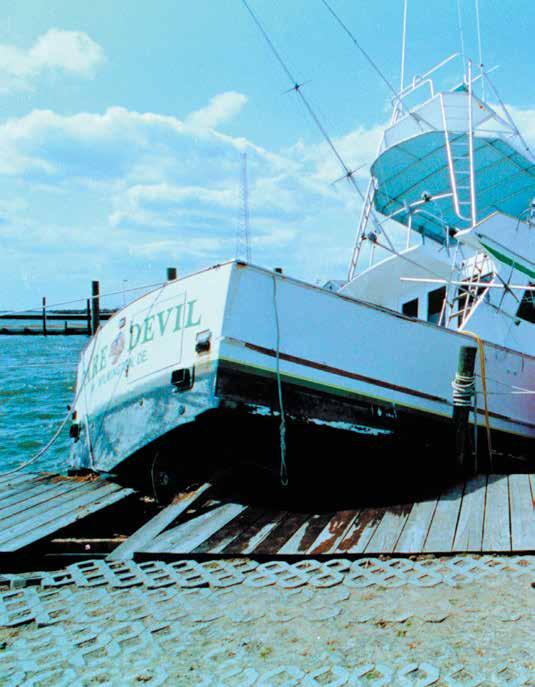
As the temperature dropped from the 60s into the low 40s the next day, Meekins says her companions began grabbing sweatshirts and other merchandise off the racks, then “watched cars go under water and a phone booth float by the windows.”
Downtown Manteo’s waterfront saw up to a foot of water inside businesses. And all across Roanoke Island there were dramatic rescues by boat. Kenn Mann recalls running full speed down the middle of Highway 345 in a small outboard with the volunteer fire department to fetch folks from inside the WOBR radio station, then pulling right up to people’s front doors in the Skyco area,
“WATER IN THE ROADWAYS WAS FOAMING LIKE RAPIDS IN A RIVER.”Oregon Inlet Marina. Photo: Drew C. Wilson
before racing off to retrieve others around the Burnside neighborhood.
“Water in the roadways was foaming like rapids in a river,” Mann remembers. “It was a frightening time.”

Button Daniels, a lifelong Wanchese resident, still says it’s the most tide she’s ever seen in her village. She watched waves rolling in and out of the windows of the house next door. At one point, flooding and snowfall were occurring at the same time. Afterward, Daniels says everyone was in shock, just pulling stuff out of their homes.
“They were the highest piles I’ve ever seen along the road. But it was a phenomenal time of neighbor helping neighbor.”
Ultimately, 18 Dare County homes were destroyed — and another 230 damaged — along
with hundreds of ruined cars, for an estimated $5 million in damages ($10 million today). All told along the East Coast, damages reached roughly $5.5 billion ($10.8 billion in 2021 dollars).
Today, “The Storm of the Century” remains the country’s second-most costly winter storm to date, with impacts from the Deep South to Canada. In the Gulf of Mexico, a 200-foot freighter sank, killing seven crew members. A cargo ship sank off Sable Island, Nova Scotia, with all of its 33 crew members perishing. Eighteen houses fell into the sea on Long Island. And every airport from Halifax, Nova Scotia, to Tampa, Florida, was forced to close. Nationally, 250 people died in the storm. And many survivors still feel its effects.

“Whoever went through that storm,” says Daniels, “has never forgot it.”
Terri MackleberryWE KNOW, WE KNOW: THE TITLE OF THE FEATURE IS “NO NAME NEEDED.” But while the most infamous superstorm of modern times may have come with a moniker — and even reached Category 3 strength as it bulldozed through the Caribbean — by the time Sandy crashed into Brigantine, New Jersey, on October 29, 2012, she was no longer a hurricane. At least technically.
to find that “the bypass was completely under water” for nearly a mile. Meanwhile, back on the beach road, Winks and Ocean Boulevard had waves “crashing at their doorstep” and Avalon Pier got “severed in two places.”
“Sandy was reclassified as ‘a post tropical cyclone’ just before landfall,” says Mark Willis, Meteorologist in Charge for the National Weather Service’s Wilmington office. “But it began transitioning into an extratropical storm, or a nor’easter, well beforehand.”
Furthermore, while Sandy’s tropical force winds battered the Outer Banks over four days as it moved up the coast — coming within 200 miles of Cape Hatteras on October 28 — it’s what transpired as she passed by that proved most devastating.
“The storm grew considerably in size as it moved north from the Bahamas due to its interaction with cooler continental air and complex upper-level features,” Willis continues. “Sandy moved back over the Gulf Stream, which allowed it to strengthen and maintain tropical characteristics, but ultimately it moved northwest back towards the Mid-Atlantic states. This allowed it to move over cooler water and completely lose tropical characteristics, as it interacted with a blocking pattern and an upper-level trough over the Southeast US. This pattern led to an extensive fetch of onshore winds aimed at much of the East Coast.”
On October 29, all that energy would focus on Kitty Hawk, where the storm surge mixed with a series of full moon tides, toppling dunes and making for a hellish Monday commute, as the overwash flooded NC 12 — and even erased 200 yards of pavement in front of the Black Pelican.
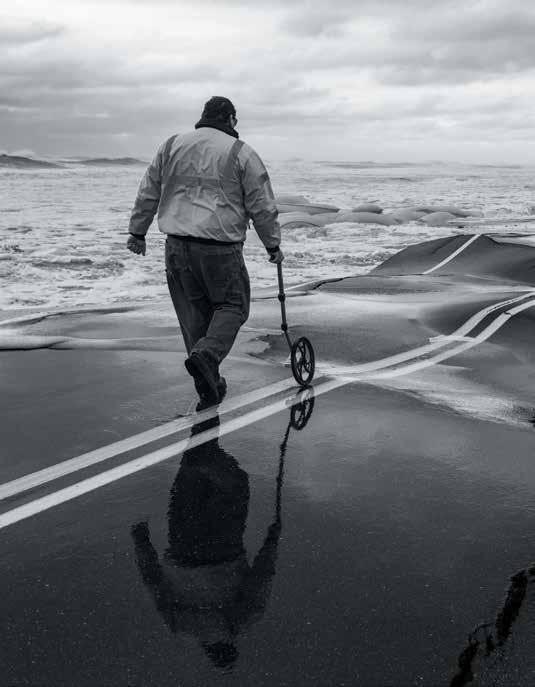
“I remember getting on the beach road and being like, ‘This is crazy,’” recalls Willis, who lived in Kill Devil Hills at the time. “There was sand and water everywhere. Road closures everywhere. I even had to put my truck in four-wheel-drive at one point. For a storm that far away, to have that significant of impacts, it was incredible.”
The relentless waves continued to push water farther inland, flooding parking lots, threatening low-lying businesses, and snarling traffic along HWY 158.
In a follow-up reflection, Kip Tabb recalled bolting to the North Beach Sun office to save his computer equipment from the rising waters, only
“The world,” Tabb wrote, “became a sodden, saltwater-soaked mess from the Hilton Garden Inn to the northern end of Kill Devil Hills.”
Hatteras Island didn’t fare much better. During her ride-along with the sheriff’s department, Island Free Press’ Anne Bowers noted that Avon Pier had lost its end section. Elsewhere, Bowers wrote, “Several vehicles sat in engine-high water and several lower houses…[were] on the brink of flooding.” In Buxton, “Six people were removed from an [oceanfront house] which had suffered severe damage.” At the Lighthouse View Motel, the pool area “was ripped apart.”
But the greatest tragedy occurred 90 miles off Cape Hatteras, when the HMS Bounty — a threemasted wooden schooner used to shoot 1962’s maritime epic, Mutiny on the Bounty foundered and sank. According to CNN, “Wind gusts above 100 mph and waves as high as 30 feet flipped Bounty on its side, tossing everyone into the predawn Atlantic.” While the Coast Guard rescued 14 of the 16 crewmembers from lifeboats, another one died after being recovered unresponsive. “The captain,” the article went on, “was never found.”
By November 1, everyday citizens began to put their lives back together. But Pablo Hernandez’s troubles were only beginning. As the Resident Engineer for NCDOT’s Division 1, Hernandez had already rebuilt the S-Curves twice over the previous three years — once following 2009’s Nor’ida and again after Hurricane Irene in 2011. But he’d never seen damage like Sandy’s, which pulverized a 2000-foot stretch, then pushed the dune line west of the marsh.
“Hurricane Sandy took out so much beach that the old cypress and pine tree stumps were exposed,” Hernandez remembers. “And the roadway and damaged portions were right at the same elevation as the beach, so there was no relief from the ocean and a constant cycle of nor’easters.”
For six weeks, there were only two ways off Hatteras Island from the north: the emergency ferry and a 4WD-only detour. And even that proved difficult to maintain, as the Weather Service issued no fewer than 35 overwash alerts for Mirlo. Each time the DOT brought in fresh sand, it
seemed another high tide or storm would sweep it back into the sea.
“At one point we were putting in sacrificial sandbags to protect the area where we were putting in the permanent sandbags,” Hernandez says. “But we finally got traffic back on asphalt pavement around December 13.”
Today, all the road’s been removed around the S-Curves and a new Jughandle Bridge diverts traffic well around NC 12’s most troublesome corridor. It’s all part a of long-term maintenance plan that expects stronger systems, more “hot spots,” and potentially more spans in the coming decades.
“Both the bridges at Oregon Inlet and Rodanthe are designed so that they can be extended,” says Hernandez. “They’re also designed for a worstcase scenario, where you’ve lost 50 feet of bottom
and a vessel is hitting the structure while you have 105 miles of wind pushing on it.”
Sandy also changed the way the National Weather Service operates.
At the time, policy dictated that once a storm lost its tropical status, the corresponding tropical warnings could also not be issued. As a result, no hurricane warnings were in effect for New Jersey and New York. Instead, the NWS relied on High Wind Warnings and Coastal Flood Warnings. Investigators later decided that bit of bureaucratic red tape caused state and local decisionmakers to delay evacuation orders. It also likely confused coastal residents who might have otherwise escaped a deadly storm surge.
As a result, as of June 1, 2013 — the very next season after Sandy — a forecaster could issue a Tropical Storm or Hurricane Warning based on the
Sources: NOAA Hurricane Sandy Event Overview, www.weather.gov; “Pier, Roads and Bridges Take a Beating From Sandy,” Oct. 29, 2012, www.OuterBanksVoice.com; “Sandy Slaps Outer Banks As She Goes By,” www.CoastalReview.org, Oct. 31, 2012; “Hurricane Sandy Assaults Hatteras and Ocracoke From All Sides,” Oct. 28, 2012, www.IslandFreePress.com; “Thoughts on Hurricane Sandy,” Nov. 29, 2012, www.NorthBeachSun.com; “Coast Guard blames Captain for Sinking of HMS Bounty,” June 13, 2014, CNN.com; “NWS Confirms Sandy Not a Hurricane at Landfall,” Feb. 12, 2013, www.climatecentral.org.
threat, no matter its meteorological make-up.

“And you can see how that made a difference just recently with Hurricane Ian,” says Willis. “Ian went extra tropical right after landfall. Prior to 2013, we may have had to strongly consider a High Wind Watch or Warning for North Carolina, instead of Tropical Storm or Hurricane Watch/


Warning — or a Coastal Flood Watch or Warning — instead of a Storm Surge Watch or Warning. But now we have the flexibility to do whatever we want.”
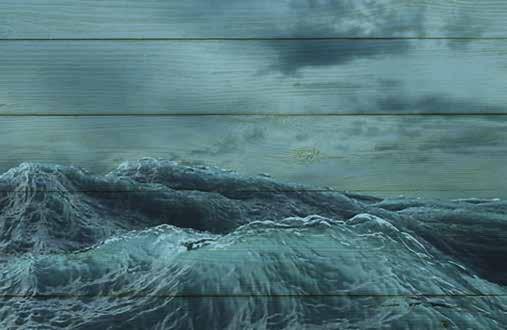

In the end, Sandy killed a total of 240 people and did $70 billion in damage. Seventy of those deaths occurred in New York and New Jersey, where 346,000 homes were damaged or destroyed. All despite not technically being a hurricane. And Willis says that’s the most important lesson.
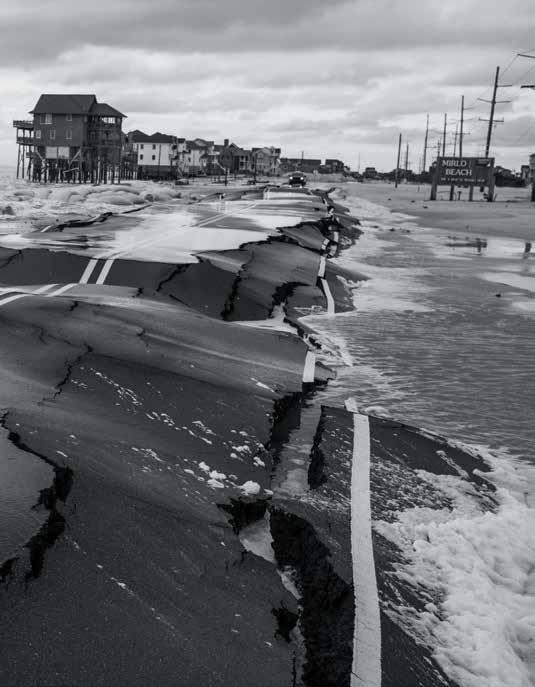
“Tropical system, non-tropical system, nor’easter — whatever you call it — any big storm is going to cause problems,” he says. “So, if there’s anything to learn from Sandy, it’s this: don’t worry about what it ‘is,’ just worry about the impacts.” — Matt Walker

“THE WORLD BECAME A SODDEN, SALTWATERSOAKED MESS FROM THE HILTON GARDEN INN TO THE NORTHERN END OF KILL DEVIL HILLS.”
GAME ON
From wood ducks to furry rodents, Marc Murray can make about any critter super tasty.

“Nutria’s not something I’d ever planned on incorporating into family meals,” laughs Southern Shores construction supervisorturned-critter culinary expert, Marc Murray. “But, then again, I’ve only just begun hunting.”
to try new things — and perhaps maybe even do some good.
“Duck hunting is very similar to cobia fishing: there can oftentimes be a lot of effort and little reward,” Murray says. “And from a sustainability and culinary standpoint, I really wanted to try my hand at other local game species, considering what we have available in our area. But from the very beginning, the concept was to put food on the table. I’m not into wasting.”
to make sure it was something I could cook. I found a recipe by a Cajun chef. And so, that year our Thanksgiving spread included braised nutria with sweet potatoes.”
More than just bagging a good meal, Murray’s doing our habitat a big service. You’ve likely seen nutria either swimming in ditches — or as unfortunate victims of busy roads. But while these giant rodents look like a long-tailed otter or beaver, they’re actually semi-aquatic swamp rats from South America. And they’re highly invasive.
Suddenly, Murray found he always had a freezer full of meat. After the first holiday feast, he began exploring new ways to prepare the tasty pests. When he discovered Hank Shaw — a James Beard Award winning chef who specializes in wild game — he decided to try his recipe for Brunswick stew, with one big difference.
“I decided to substitute nutria for the possum,” Murray says. “Because the two are supposed to be very similar in flavor and texture.”
While he grew up surrounded by sportsmen, Murray never had the urge to harvest wild game himself — until COVID hit. Flush with extra hours and a desire to be outside, he began duck hunting with his brother. But the more Murray learned about his newfound pursuit, the more he felt like he was killing more time than food. He also began wondering if he was missing a chance
At first, Murray figured he’d expand his tastes to wood ducks and teal. Maybe the occasional squirrel. He’d never even considered nutria. But one day, while hunting ducks, the opportunity just popped up — literally.
“Usually anywhere you duck hunt you will see nutria swimming around,” he explains. “And since the duck weren’t making an appearance that day, I decided to google ‘nutria’ from right there in the duck blind
After being introduced to the Outer Banks in the mid-20th century as a means to control weeds and noxious plant species, they soon developed a taste for aquatic vegetation and grasses. In fact, nutria have so decimated our native marshland that there is no closed season and no bag limit for them.
“Once you have your hunting license,” Murray notes, “you can hunt them yearround.”
Before proceeding with any nutria dish, it’s important to remember that, while you can hunt them year-round, you should only harvest them for eating in the winter under cold-water conditions.
“There are high levels of bacteria in the water during the summer months, which makes it unsafe to consume the meat,” Murray notes.
He also warns that processing the animals can be somewhat unpleasant, but there’s an easy way to make the meat tender and delicious.
“The first thing you’ll notice when you’re cleaning these animals is that they smell like where they’ve been living — in the mud,” says Murray. “So, I like to brown, braise and then hand pull the meat.”
That’s the secret to his savory Brunswick stew. Traditionally speaking, this southern dish starts with a tomato base and includes veggies, beans and meat, usually chicken and pork. But earlier concepts included wild game and whatever local ingredients were available in the pantry.
Murray’s recipe is obviously a nod to the original versions. It’s hearty, flavorful and ohso-comforting. It’s also surprisingly complex. Even for the most sophisticated palates.
“This stew actually pairs really well with wine,” Murray insists. “We got together with our friends from Sanctuary Vineyards and had a little wine dinner at our house. It turned out great!”
Local wine isn’t the only homegrown element Murray likes to pair with his nutria stew. He’ll also use chunks of squirrel meat. And that’s just one of his favorite recipes for this plentiful rodent.
“Squirrel can also be used in a lot of other dishes,” he says. “We’ll braise them in a cilantro-lime marinade for 3-4 hours and then make the best tacos you’ve ever had.”
The other good thing about squirrel is there’s lots of places to hunt them close to home. (Murray has a few honey holes in Kitty Hawk Woods and Currituck Banks Preserve.) But he’s always looking to explore new grounds, so this year he plans to stretch
his range to include Carova and Alligator River.
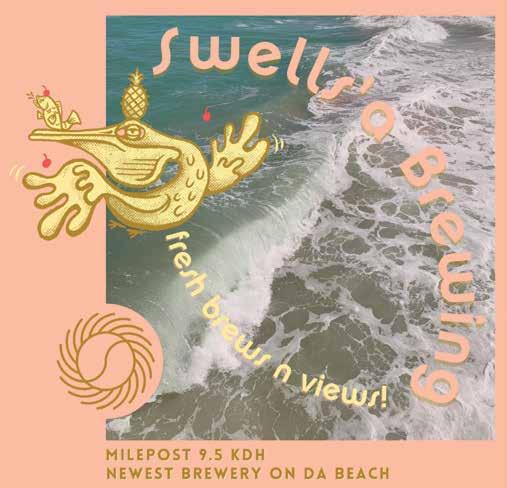
Meanwhile, he hopes to expand his horizons to include more species, like deer, wild pigs and ground hogs. And he’s already shooting more waterfowl.
“I actually got my first swan last year,” Murray beams. “That was pretty special, because there is a limited number of permits available and you’re only allowed to harvest one per person, per year.”
Needless to say, Murray wasn’t about to risk ruining such a rare bird.
“Much like goose, once it’s overcooked, swan can become very liver-like,” he says. “So, it’s important to take your time. We went with our old standby and made some very tasty swan tacos.”
Nearly three years since his first duck hunt, Murray is out in the woods or on the water as much as possible. If it were up to him, he’d be eating wild game exclusively. But other factors like time and family tastes keep him reined in.
“I do have my wife and daughter to consider,” he says with a laugh. “And it’s not like cooking fish, where you can have the meat on the table in 15 minutes. Wild game often takes hours between the prep and cooking.”
Still, he figures he eats wild game once or twice a week when he has meat on hand. And whether he’s shooting a squirrel, searing a goose breast or processing an environmental pest, Murray now sees hunting as an essential part of life. Because he recognizes it’s about so much more than just “the kill.”
“Hunting really has changed my life,” Murray says. “It’s something you put so much effort into. In the beginning, there’s even a certain amount of guilt, but eventually that begins to melt away. I realize after all these years of not hunting that there’s a connection that happens with food and family. For me, that’s what makes all of this so special.”
Kitty Hawk - 3712 Croatan Hwy. - 252-255-5590
Scarborough Faire Shops, Duck - 252-261-8981
Historic Corolla Village, Corolla - 252-453-2292
Open Books = Open Minds! islandbooksobx.com
— Fran Marler
“MORE THAN JUST BAGGING A GOOD MEAL, HE’S DOING OUR COASTAL HABITAT A BIG SERVICE.
YEAR, MAKE AND MODEL. “Stephen Brown of Zack Mexico once called us “Shoegazi,” which we thought was hilarious, because we do touch on genres like shoegaze and punk. But from the moment we formed in 2018, the mutual talk was about always evolving and not being stuck in any genre. Our goal is to find a sound that’s impossible to describe — something that always stays stuck at the tip of your tongue.”
To see a Cor de Lux concert is to be transfixed. Just watch the crowd. Eyes wide and swaying, totally mesmerized as the band builds from one sonic crescendo to the next. It’s almost like a mass hypnosis. Which would explain the humble fourpiece’s rapid ascent.
In January 2019, they played their first gig at Ashley’s Espresso Parlour. By fall of 2022, they were on a “baby tour” backing top indie acts from Atlanta to Brooklyn — not to mention making the main bill at Raleigh’s Hopscotch Music Festival. But ask the band about it, they’ll say there’s no magic behind their warp-speed momentum.

“We’re basically untrained musicians who unleashed whatever came out naturally,” says singer/guitarist, Dawn Moraga. “And then we just followed where it wants us to go.”
We sent them a questionnaire between gigs to hear about life on the road — and see what it means for their future journey.
— Leo GibsonWHO
WHAT? “Tim Lusk is Guitarist/Van Conductor/Tech Guru — he steers the wheels, records our albums, facilitates the band space, and color codes all our cables. John Bliven is Bassist/Steady Eddy because he’s always on time — and he records all shows and jams so we know what we did right and wrong. Dawn Moraga sings, plays guitar, schmoozes fans, and somehow carries all the gear. Thomas McNeeley plays drums. He just joined us this year, but he’s a natural fit for our sound — and he’s great at booking and all the important behind-the-scenes work. (Before Thomas, we didn’t even know what an EPK was.)” (Ed note: it’s an “electronic press kit.”)
ROAD TRIPPIN’. “This year was the first time we’d been on the road for more than two days. And it’s not easy getting booked after COVID shut things down for two years. (We hit up probably 20 bands just to get a show in DC.) But we wanted to hit the ground running before our album comes out in January. We were fortunate enough to open for LA Witch in Durham and Asheville — both of which sold out and were incredible. And a house party at Two Scoops in Atlanta with Vessel, Jr Joy, and Telemarket was another one of our favorite nights. But Hopscotch was probably the biggest deal and our best energy to date because both shows were at capacity — at the end we were shaking because it felt so good. And just being able to play with some big inspirations — and some new young bands that blew us away — was a huge opportunity.”
LUXURY RIDES. “At Hopscotch we were watching Kim Gordon [of Sonic Youth] do her soundcheck from our hotel room and thinking of all the years she’d inspired us. We were bummed, because we knew we had our soundcheck at the Pour House at the same time she did her show. Then, leaving the hotel, we got in the elevator, and it was her. Dawn couldn’t breathe for two floors. Then right before she stepped off, Tim looks up and goes, “Oh! I didn’t recognize you. We love you.”
MINOR ACCIDENTS. “Dawn broke a string during a live online set for ‘At the Addition’ — literally hours after we were talking about how none of us had broken a string on stage. Some beer got spilt on the pedalboards. And we almost got lost in the mountains. But we wouldn’t change a thing musically — besides maybe wanting our vocals to be better at times — because the music happens like it’s supposed to happen.”
STEP ON IT. “A lot of our sound depends on pedals. Dawn’s favorites are Hungry Robot and Death By Audio’s “Apocalypse.” Tim is such a perfectionist; he never stops buying and returning pedals to find just the right sound. John keeps it pretty basic with a couple selections. And Thomas’ kit tops us all — he can even syncopate our heartbeats with his bass drum.”
LEFT OF THE DIAL. “We’ve made a lot of fans and friends via online radio, grassroots blogs and all the smaller indie stations and websites. We recently found out a blog from Latvia shared our music. (We had a friend translate it later, and luckily, they said all nice things.) And we

were shocked last year when Henry Rollins played “Gravity Kills” after we emailed him. He’s since played a couple of our latest singles and four more songs off of the first album.”
NOT FULLY LOADED. “I wouldn’t say that we’re straight edge. But we definitely don’t like to be altered before shows or for creativity, because we don’t want anything to overshadow the music. And we don’t believe in Big Pharma or heavy substances. We also work with Musicians for Overdose Awareness on supplying free Narcan for venues or bands because fentanyl is tearing apart our country.”
ROUGH PATCHES. “With any ‘second family’ there are going to be bumps in the road. But we all seem to be able to apologize when needed and not hold onto things that should be left behind. Part of it is because there’s no Alpha person or ‘lead’ anything. We write all of our songs through a jam that progresses into something. And if one of us isn’t into it…it gets dropped. Because the energy can’t build a house if there’s not four walls.”
FRESH TRACKS. “After 1.5 years of writing and mixing, we’re really excited to release our sophomore album, Media. It’s all about the social media wars and the spread of misinformation, and all the hate and pain we saw humans direct toward each other during COVID. But don’t get us wrong, we aren’t anti media — we are anti division. It’s also got a new sound, with more postpunk elements, so it’s a real labor of love.”
OVER THE HORIZON. “Who knows what’s next? New videos? New music? More tours with our favorite bands?

There’s definitely no desire to be huge because we don’t think it’s necessary. (A lot of our favorites are mostly unknown.) And we’re not courting any labels because we don’t want the DIY rawness to ever leave us. We’re really all just on a journey of where the music wants us to go. So, all we can do is book shows and keep playing and see where it takes us.”
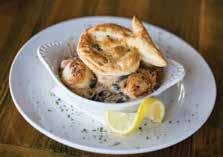
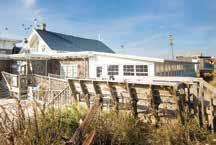


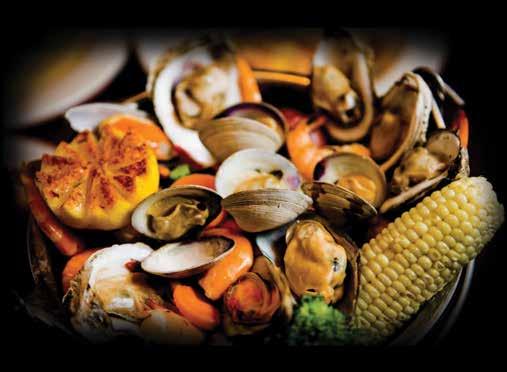
“ “OUR GOAL IS TO FIND A SOUND THAT ALWAYS STAYS STUCK AT THE TIP OF YOUR TONGUE.”
Don’t think of them as toys. Or action figures. Or even sculptures. No, the best way to understand Chris Gray’s artwork is to see it as next-level fan fiction. Except, instead of drawing 2D depictions of his favorite cartoons — or typing out fresh stories for the Marvel multiverse — he reimagines brand new heroes inspired by every conceivable media, then brings them to physical life one at a time.
Step into this mad scientist’s makeshift lab, you’ll find homages to Teenage Mutant Ninja Turtles and Masters of the Universe. A Clockwork Orange and The Godfather. Fruit Loops and Happy Meals. All mashed together in creative new ways, perfectly polished from concept to packaging. It’s a sugary sweet speed ball of pure childhood memories and unadulterated American
consumerism that’s simultaneously funny, comforting and ridiculously addictive. Because while he mostly works in plastic and resin, his true medium is nostalgia.
“So, these are all things we had when were kids,” says the 38-year-old KDH resident, pointing to his garage’s massive display of hand-made spinoffs that harken back to ’80 and ‘90s entertainment. “When you see them, it takes you back to that frame of mind — that imaginative spark — before everything got all serious.”
It’s not just a hobby — it’s a business. (Each figure can fetch more than $100 on his website.) And it’s not just him. Gray is part of a tightknit subculture where a few hundred DIY toy makers add their own clever twists to world-famous franchises — often using

humorous, pointed messages — and fans clamor for a clever, limited-edition tribute to a favorite memory.
It’s a world where artists like Ron English gather 260,000 Instagram followers for building tangible puns like “OK Doomer” — Charlie Brown as a wrinkled old codger — or skewering America’s dietary habits with tongue-in-cheek sendups, like a “supersized” Ronald McDonald or “Sugar Diabetic Bear.”
And the consumers? Some are collectors run amok. Star Wars nerds who have every official release — so a never-seen-before pink Stormtrooper proves irresistible (whether or not they’re part of the “Gay Empire”). And some are just lifelong fans who can’t resist owning a limited-edition tribute.
“I love MF Doom, so I bought this figure on Etsy,” he explains, pointing to a king-sized vinyl statue of the rapper. “I was already dabbling in casting and making silly projects. I realized I could actually do this.”
It took a few years. His earliest works are rough resin molds of a shadowy kid flying a giant cockroach — a testament to his own childhood, when he used to tie fishing lines to bugs and fly them around. The onecolor figures aren’t very detailed. And the packages are rough. (Think desk-jet printed paper stock and scotch-taped plastic bubbles.) But with some YouTube tutorials, and a lot of trial and error, Gray refined the process over an endless evolution of ideas, mixing two or more compelling elements into strange, new creatures. No deep political messages or crazy agendas. Just whatever strikes him as clever.
“A lot of what I do is just what I think is funny,” Gray says. “Like, I always thought that Boo Berry looked like the meth dealer from Breaking Bad, so I made ‘Heisenboo.’ And I mixed Donatello from the Ninja Turtles with Don Corleone from The Godfather.”
“But Gutbomb was really the igniter,” Gray continues, holding up the brand ambassador for his line of Genetically Modified Organisms. “I basically put Krang from the Ninja Turtles onto Cap’n Crunch’s body. I made 12, and they sold for 50 bucks each. So, I just kept doing it — but I kept doing it in different ways.”
Today, Gray’s got a whole bunch of Genetically Modified Organisms that he markets under an umbrella label called Artificial. Most of his creations start with an existing action figure. He’ll use epoxy molding to add certain features. Maybe even swap heads with another character. Next, he creates a silicon mold and fills it with resin. Pops it into a pressurized chamber to squeeze out the air bubbles. A few hours and a fresh paint job later, he has a brand-new protagonist, mixing everything from boom boxes to juice boxes to big screen block busters.
“For Sloth, I took a Toxic Crusader out of my closet, added to his head and sculpted the
Superman “S” on his chest,” Gray says. “Or, sometimes I just recast a toy, then repaint and repackage it. But I’m gearing toward original sculptures. For those, I get a 3D design made from an existing sketch, then I make the mold.”
That’s how it was with Yardbird. At first, this super buff, cyborg chicken was just an idea in his book. Then he sent his sketch to California to get digitally rendered. A couple months later, they sent back a six-inch sculpture that Gray could cast and paint however he pleased. And here’s where his artistic talent shines, as he painstakingly colors in the tiniest details by hand, making them look totally identical to the naked eye.
“The hardest part is the black lines, because you need a tiny dip brush,” he says. “Those are the toughest.”

Even so, Gray reckons he can cast and complete 24 figures in a week. But he can’t do everything all by himself. That’s why he’s hired a pair of top-notch illustrators to bring his visions to greater life on eye-popping packaging. (Not to mention posters, trading cards, shoes, and cereal boxes.)
“We’ve been real fortunate to sell hundreds of pieces over the years,” he says. “It covers the costs and allows me to hire guys and collaborate with other artists.”
He’s even sent Gutbomb to China to be mass-produced in 10-inch vinyl. But it all comes back to Gray for final assembly, at which point he painstakingly glues the graphics onto cardboard cutouts — both sides — then vacuum seals each figure behind a see-through plastic bubble. He even punches a hole in the top. The final product is so perfectly legit you can’t tell if it’s made by Mattel or 100% Artificial. In fact, it could literally hang in any toy section and not stick out.
And that’s the whole point: to recreate the experience so that the snobbiest collector can’t help but purchase it — then be so smitten they can’t stand to open it.
“We joke about it a lot,” says Gray. “Some collectors will be like, ‘Do I take it out or do I keep it in the package?’ I’ll say, ‘Buy two so you don’t have to make a choice.” [Laughs]
Once they’re ready, he posts a sales pitch to Instagram under the handle @jumbo_ nuggatron. Then sits back and waits for the orders to come in. All told, he reckons he spends about 20 hours a week on some stage of the process, whether it’s painting figures or packing boxes.
“I ship a couple of times a week,” he says. “But, you have to keep doing new pieces to keep momentum. So, you have to keep cranking. Besides, you never know when the right idea’s gonna hit.”
Which is why he perpetually reimagines every concept until he’s run out of ideas. Might be a new resin tint. A different color scheme. Or another out-there-combo. (Even his Yardbird’s gotten both a Toucan Sam and Cocoa Puffs paintjob). If it strikes the right nerve, a single idea can set off infinite offshoots. And generate serious cash.
“We auctioned off limited, hand-painted copies of five vinyl Gutbombs,” Gray grins. “They went for $500 each.”
Don’t worry: he keeps the first three iterations of every idea for his private collection. And he can always make more — as long as it’s different. That’s the only real rule to his creative process. Everything has to evolve. Whether it’s casting a favorite concept in Day-Glo material or developing a totally new toy line. (Watch for a new series of characters coming soon called “Biologic Mutations.”) Most recently, he’s been researching how to get his Cosmic Surfer a shiny chrome coating. But no matter the final product, each time he pops the pressure chamber, he gets the same joyous sensation.
“Opening the mold, it’s a feeling like opening a gift when you’re young,” Gray beams. “Like a beautiful surprise.”


 — Gia Jeaux
— Gia Jeaux
“THERE’S ONLY ONE RULE TO HIS CREATIVE PROCESS. EVERYTHING HAS TO EVOLVE.



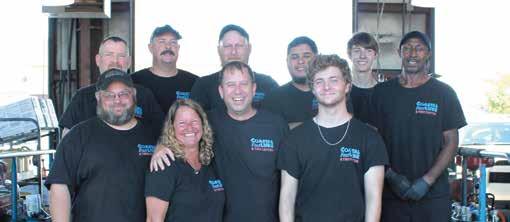

“So, other than hunting ducks, this marsh ain’t worth nothing is it?”
“What?” The question kind of catches me off guard. “I wouldn’t say it that way, but now that you have, I’d have to agree. This marsh most certainly isn’t worth nothing. Far from it, as a matter of fact.”
Dude just continues on, double negatives and all.
“…can’t build nothing on the marsh because it’s protected, and you can’t grow crops ’cause of the saltwater…”
Dude shoots me a side-long glance.
“When are we going to get more shots anyway? Actually, if you’d figure a way to grow crops to feed the ducks, we wouldn’t have to wait like this...”
Dude’s just about gotten under my final layer of skin, I muse to myself. I bite back the snappy retort and instead focus on the area of sky above and on either side of the Bodie Island lighthouse. Early afternoons like this, that air space is our most likely opportunity at another shot.
bugs and other stuff float up. A bird’s like any other critter. He’s going to feed where he can get the most nutrients for the least amount of effort…”
I start warming to my subject, knowing better than to let the lecture lag.
“…throw in not wanting to get shot in the face, and that’s why gunning’s slow today. Oh. That and it’s a clear and sunny fall day on the eve of a hugely full, harvest moon.”
“Besides…” — I can’t help but get in a little dig as I keep on with my edification — “… we’re already doing better than we have a right to expect on a monumentally ‘blue bird’ day like this. That hen pintail and gadwall you’ve got will feed you and your family. You just need to relax. We’ll get some more shots, or at least we’ve got a better chance here than we would back at the hotel…”

“And by the way,” I add, a cold look to my eyes, “I’ve had a chance to think about what you said earlier. And that bit about the marsh being worth nothing is nothing but pure bullsh…”
My communication skills are also hampered by the fact that I can’t recollect Dude’s name. Went right in one ear and out the other in the freezing predawn hours of the 7-11 parking lot. (Anybody who knows guides knows that our brains are full in the morning. People can die if we screw up.)
‘Dude’ is a better name for him anyway, I continue in the privacy of my mind. Dude is a dude. A shooter and a body piler-upper. Certainly not a sportsman. No student of nuance, this one. Been doing this stream-of-consciousness complaining thing since before light. Jeez. Is this what being a duck slut feels like?
Quiet reflection doesn’t seem to be working so well for me. And then…
“Wild celery grass.”
I say it all of a sudden. Just the three words. Takes Dude by surprise.
“Look around. A thousand acres of wild celery grass, created by a just and loving God and put in front of us right up to the shoreline. Best natural food for wild waterfowl in the world. When the water drops out, ducks swarm to it and gorge themselves. Today’s not that day, though…”
I keep talking to keep Dude from filling the gap.
“...Today, because of the west in the wind, the water’s high. When the water’s high, the marshes flood, especially around the refuge’s ponds. When the refuge floods, seeds,
Thankfully — because what I was about to say was sure to sink my tip — right then, I spy five widgeon over the lighthouse. Five hundred yards out — 300 yards up — wings already cupped and coming right at us, in a pitch that goes past beautiful — and straight to spectacular.
I’d like to say that at that moment, Dude finally gets it. That it’s not the pile of death and feathers that matters; it’s visions like these and the celebration of life that we get to experience en route to another fine meal of healthy, wild game provided by ourselves, our patience and our skills.
I’d also like to say at that moment, the fowl begin to flood to us, and we both shoot limits.
Dude whiffs on all five widgeon — plus another pair of drake pintail just before sunset. In fact, turns out that Dude’s family won’t eat the kills he got. He’s too…whatever to clean and cook for himself. Because Dude doesn’t get it. Never got it. And probably never will.
For me though, it’s but another beautiful day at Pintail Point. I go home with both of his ducks, plus the thirty fat oysters that I picked up when I took a little wander to escape his ignorant nattering — not to mention the money he paid me to guide him around.
Absolutely, I think, as he hands me the pair of birds and a stack of crisp bills. This marsh most certainly ain’t worth nothin’. — Victor Berg




Harsh winters come in many forms. That’s why Beach Food Pantry offers Free Holiday Meals for hungry families through Dec. 31. To add perishable products, like vegetables and dairy, as well as culturally appropriate items, order at www.bfpselfcheckout.org. And learn more about this essential community service at www.beachfoodpantry.org

• Want your Thanksgiving horn o’plenty to be extra healthy? On Nov. 23, head to Secotan Market in Wanchese from 9am to noon for a wide selection of organic produce, vegetable ferments, artisan meats, and more. After that, Secotan’s Cool Season Markets take place on the 1st and 3rd Sat. of every month, Dec.-Apr. 9am-12pm. Find the freshest news at www.secotanmarket.com. • On Nov. 23, learn how our 1850s families prepped a feast — and prepared for winter — at Island Farm’s Garden to Hearth, where costumed interpreters demonstrate traditions from pickling roots to smoking mullets to making candles. 9am-3pm. $10. (Ages 3 and under are free.) For more info visit www.obcinc.org. • Pound beers? Pound pavement? Do both when the Tipsy Turkey 1-Mile Beer Run returns to the Outer Banks Brewing Station, Nov. 23. Prizes for fastest finishes and wildest costumes. 11am start. Dash to www.obxrunning.com for details. • On Nov. 24, a number of footraces kick-off Thanksgiving Day, from Corolla’s Wild Turkey 5K to Nags Head’s Outer Banks Gobbler 5K to Avon’s Surfin’ Turkey 5K to the Ocraoke Island 5K Turkey Trot. Might be too late to join the pack, but you can always cheer from the sidelines. Google for times and locations. • Rather watch lit-up boats do some laps? On Nov. 25, set sail for Ocracoke’s Parade of Boats, where holiday themed vessels add extra sparkle to Silver Lake. 5-6:30pm. Learn more at www.visitocracokenc.com. • And Corolla’s awash in Yuletide events starting Nov. 25, when the 7th Annual Christmas Craft Village covers the Whalehead grounds in arts and crafts, handmade cosmetics and baked goods — plus food and photo ops with Mr. & Ms. Kringle — to create a super fun shopping affair. (11am-4pm.) Stick around, ’cause Whalehead’s Christmas Candlelight Tours occur every Fri. & Sat., Nov. 25-Dec. 17, serving up 1920s holiday decor and greenery — plus a live performance on the original, one-of-a-kind Steinway piano. (Starts promptly at 5pm; $20. Call 252-453-9040 to reserve your spot.) Then skip over to the Corolla Christmas Village, where lights and holiday sites fill the historic settlement with festive spirit, every Fri. & Sat., Nov. 25-Dec. 30. (5-8pm.) Find details on all these shindigs at www.visitcurrituck.com.
• Soar down to Kitty Hawk Kites in Nags Head, Nov. 25-26, for the annual combo of Hangin’ With Santa and Kites With Lights. Pop into the store on Fri. & Sat. for pix with a glider-piloting St. Nick. Come Sat., scoot over to Jockey’s Ridge, where glowing 19-to30foot kites fill the skies from 4-7pm. In-between, a 5pm lighting of the Solar Christmas Tree illuminates the season. Get the twinkling deets at www.kittyhawk.com.
• The first of three Dowdy Park’s Holiday Markets flares up with locally made gift opportunities on Nov. 26, from 9am-12pm — with two more dates: Dec. 1 (4-7pm) and Dec. 19 (9am-12pm). And bring the kids back for some evening fun with a 5pm Nags Head Tree Lighting Ceremony starring Santa on Nov. 26, and a Dec. 15 Candy Cane Hunt. (5pm start; bring flashlights


for participants.) Follow the park’s Facebook page for updates. • Did someone say, “Bigger than Santa?” On Nov. 26, Outer Banks Forum for the Lively Arts presents Liverpool Legends! This Beatles tribute has traveled the world from Britain to Branson. Now, they’ll add First Flight High School to the list. 7:30pm start. Get your ticket to ride at www. outerbanksforum.org. • Stick to designated trails — or you might get stuck in worse places! That’s the warning for anyone hiking Nags Head Woods, as Bow Hunting Season runs till Jan. 2, with an extended season from Jan. 14- Feb. 19. Find a trail map at www.nature.org • The 10th Annual Outer Banks Entrepreneurs Holiday Bazaar makes the most of Small Business Saturday on Nov. 26. From 9am-5pm, 50+ vendors fill the Comfort Inn South with handmade and readymade items, plus holiday jams by DJ Cowboy. Learn more on Facebook • Sanctuary Vineyards bustles with bands and bivalves when The Big Currishuck returns Nov. 26. From 12-5pm, enjoy all you can eat oysters and crabs, plus local beer and wine, hayrides, games, and live music by Jesse Chong and the Daniel Jordan Band. Tix available at www.sanctuaryvineyards.com • Wanna live like the OG locals? Try Frisco Native American Museum’s Winter Workshops, where Native Cooking Classes cover everything from Sweets & Desserts (Nov. 26) to Small Meals (Dec. 10) — both from 1-4pm — while Native Crafts include Dream Catchers (Dec. 17, 2-4pm) and Pine Needle Basketmaking (Dec.3, 1-4pm). $20. Call 252-995-4440 to register. (Private sessions available for groups of 5 or more.) And be sure to check out the new Longhouse Room exhibit any Tues.- Sun., 10:30am-5pm, before Jan. 1. After that, it’s weekends only till Easter. More at www.nativeamericanmuseum.org. • ’Tis the season to get extra-lit, as four favorite watering holes undergo holiday makeovers. On Nov. 27, Lucky 12, Goombays, Mama Kwan’s, and Bonzer Shack will close their doors to redo their decors. Come Dec. 1, they’ll reopen as Jingle 12, Goombrrrs, Mama Klaus’s and the Broken Candy Cane — each with a unique yuletide personality. Besides over-the-top displays, enjoy Christmas-themed appetizers, adult and kids’ cocktails, plus special events like a Bad Santa Sunday Brunch and Adult Gingerbread House Decorating Contest. Follow social media feeds for deets and updates. • On Nov. 27, Elizabethan Gardens’ WinterLights will celebrate the spirit of giving by holding Virginia Dare Night, where locals are invited to witness the eyepopping wonder of this glowing wonderland totally free — provided you bring nonperishable donations for local food pantries, and proof of Dare County, Currituck County or Ocracoke Island residency. (Doors open at 6pm; guests must reserve tickets online.) Can’t make it? Don’t be a Scrooge. A little green gets you in almost any Tues.-Sun. from 6-9pm, Nov. 26- Dec. 30. (Closed every Mon., as well as Dec 24 & 25). Find details, tix and more at www.elizabethangardens.org.) • Come Dec. 1, put the focus on one giant candle by celebrating Currituck Beach Lighthouse’s 147th Birthday, where folks climb the beacon for free from 9am-5pm. Even better, buy a season pass and score a bonus gift: unlimited visits to Island Farm in Manteo. More at www.obcinc.org. • Put that pass to work immediately, Dec. 1-3, when Island Farm’s Christmas on the North End revisits traditional mid-19th century holiday foods and traditions. From kettle corn to candle making to ornament crafting, there’s nary a modern convenience in sight! (Except for some smartphone selfies with St. Nicholas.) 3-7pm. $10 for ages 4 and up. See www.obcinc.org for the latest.
• Wanna enjoy some sick hoops while helping sick families? Head to First Flight High School, Dec. 1-3, for the Good Guys vs Cancer Basketball Showcase, where top regional and national teams fill the bracket — and every ticket sold goes toward defeating the ultimate foe. More at www.phenomhoopreport.com. • Drop the ball and get ready to bailar, when the Festival Latino de Ocracoke returns Dec. 2-3, filling our favorite island neighbor with cultural contributions, from legendary folklore to lively dances to spicy flavors. Deets at www. ocracokealive.org.

• Or enjoy a double shot of holiday memories courtesy of Theatre of Dare. First, The Man Who Came to Dinner revisits the classic, comic tale of an egotistical New York DJ who nearly ruins an Ohio family’s holiday. (Plays at the Kitty Hawk HQ, Dec. 2, 3, 9 & 10 at 7:30pm; Dec. 4 & 11 at 2pm.) Then hear BB gun nut Ralphie Parker rapid-fire funny anecdotes when A Christmas Story: The Reading comes to Dare Arts in Manteo,




Dec. 15-17 (7:30pm) and Dec. 18 (2pm). (PS: Wanna play Ralphie? Auditions are Dec. 5 at 6pm at Dare Arts.) Find tix and full descriptions at www.theatreofdareobx.com. • And nothing’s more nostalgic than Downtown Manteo, Dec. 2-3. Come out Fri. eve for the annual Town of Manteo Christmas Tree Lighting, where the waterfront teems with hot chocolate, carols and holiday cheer — before Santa lights up a big, fat conifer at 6pm. (PS: be sure to step inside Dare Arts for kids activities and holiday music by The Jingles, and to see the opening reception for oil paintings by Tamra Harrison Kirschnick.) And come Sat., the Town of Manteo’s 50th Annual Christmas Parade promises an extra special selection of speeding Shriners, marching bands and flying candy. Starts to roll at 10:30am. (Line up way earlier for better view.) More at www.manteonc.gov. • After the parade, march directly over to Outer Banks Distilling and buy a ticket to Manteo Preservation Trust’s 15th Holiday Tour of Homes. This annual, self-guided favorite visits a decked-out selection of architectural standouts from 1-6pm. Don’t wanna walk? Manteo Cyclery is supplying bikes on a first come, first served basis. $25. Ticket sales start at noon. Full sched at www.manteopreservationtrust.com • Or scurry up to Dec. 3’s 12th Annual Duck Yuletide Celebration, where families gather for music, treats, carols, and Santa, culminating with the lighting of the Crab Pot Tree. (3-5pm.) And pop into Town Hall any Mon.-Fri. by Jan. 26 to feel the magic of Jackie Tury’s “Witness To Wonder” art exhibit. 9am-4:30pm. (Holidays excluded.) Full deets available at www. townofduck.com • Hark! Angelic voices sing holiday carols, Dec. 4, when The Bryan Cultural Series presents a free performance by the Elizabeth City State University Choir at Nags Head’s St. Andrews By-The-Sea Episcopal Church. 4pm. Tune into www. bryanculturalseries.org for more. • Want to expand your knowledge on a local environmental issue — all while enjoying tasty beverages? On Dec. 8, head to Waveriders




gokite milepost

where OBX Green Drinks mixes potent refreshments with powerful speakers the second Thurs. of every month, starting at 6:30pm. Follow their Facebook page details. • On Dec. 9, St. Nick literally comes to the rescue, when the Manteo Santa Ride sends everyone’s favorite fat man around Roanoke Island on a big red firetruck. (Starts at 5:30pm.) And come Dec. 10, it’s your turn to deliver warmth and generosity to needy families, as the Manteo Food and Coat Drive asks folks to drop warm clothes and non-perishable edibles at Manteo Town Hall and the Pea Island Cookhouse between 10am-3pm. More at www. manteonc.gov • Forget the partridges and pear trees — bring on the waterfowl and wild bear! On Dec. 9-11, the 2022 Wings Over Water Wildlife Festival fills a long weekend with birding, paddling, photography, art, and natural history programs. Find a full wish list of events at www.wingsoverwater.org • Then join all the loony-birds Down South for Dec. 10’s annual Hatteras Village Christmas Parade, where local floats display their holiday finest, followed by hot chocolate and cookies. (2pm start.) And be sure to visit the Hatteras Village Park Holiday Trail Light Extravaganza, where lights and décor add a festive touch to the peaceful stroll, from Nov. 27-Jan 6. For more info, email hatterasevents@yahoo.com. • Wanna show off your tackiest yuletide plumage? On Dec. 10, Pangea Tavern’s Ugly Sweater Party offers prizes in three crazy categories — Most Creative/Funny; Ugliest Holiday Sweater; and Can’t Take Home to Mom — while tunes by After School Surf Club make everyone shake their tailfeathers. Want dinner to boot? Make a reservation by calling 252-995-3800. • Back in town, Dec. 10’s Colington Yacht Clubs Holiday Boat Parade sends a dizzying display of colors swirling around Colington Harbor from 4:45-6pm. Find a full itinerary at www. colingtonyachtclub.com. • And let heartfelt carols fill your sails with two performances of Holidays with the Outer Banks Chorus: Fri., Dec. 16, at Holy Redeemer Catholic
Gather at the Duck Town Park for holiday music, activities for the whole family, tasty treats, the lighting of the Crab Pot Tree, and Santa! Bring Donations for the OBX SPCA and Beach Food Pantry.
gosurf

SATURDAY, DECEMBER 3 3:00 – 5:00 p.m.



Shop local and Keep the Cheer here! Arrive early to stroll around the village. Our shops and restaurants are open and have something for everyone on your list.
townofduck.com 252.255.1234

graphiccontent outthere gohunt rearview

Church (7pm); and Sat., Dec. 17, at St. Andrew’s By-the-Sea Episcopal Church (4pm). More at www.obxchorus.org. • Sadly, we lost Col. Gail Halvorsen this past year. But the Candy Bomber is still coming to town for three days of high-flying events, Dec. 16-18. On Fri. evening, head to the Virginia Tillet Community
Dec. 17, help them go even huger by heading to Rodanthe’s KOA Campground for Shuck Hatteras — a brand-new fundraiser featuring roasted oysters, raging bands, last-minute holiday shopping, and lots of salty locals. Follow their Facebook event page for updates. Interested restaurants and vendors email











run full steam into 2023 with Tortuga’s Lie’s Annual Unofficial Beach Road 5K, where jogging fiends and health nuts gather for a sweaty salute to the coming year. No registration; just show up ready to roll by 10:45pm. Head to www.tortugaslie.com for the latest. • Real locals know the holidays’ ultimate rager arrives two weeks late. On Jan. 7, Old Christmas turns the Rodanthe-Waves-Salvo Community Center into a happy melee of oyster shoots, OG camaraderie, and the occasional grudge match. If you’re brand new to the area, it’s a great way to meet Old Buck and the rest of the Hatteras wildlife. • Wild tales continue when Theatre of Dare presents Exit, Pursued by a Bear, featuring all the necessary elements of a dark revenge comedy: an abusive husband, a fed-up spouse, a stripper named Sweetheart, and a hungry grizzly. Watch the fur fly, Jan. 20, 21, 27 & 28 at 7:30pm, and January 22 & 29 at 2pm. More at www.theatreofdareobx.com • Then it’s the outlaws’ turn to shine, Jan. 21, when the Outer Banks Forum for the Lively Arts presents County Rewind, where Nashville studio gun-slingers
Swearingen & Kelli channel the likes of Merle Haggard, Waylon Jennings, Willie Nelson and more. 7:30pm at First Flight High. Deets and tix at www. outerbanksforum.org • On Jan. 25, find out what’s shakin’ — and enjoy eggs and bacon — when Dare Commissioners State of the County Breakfast Meeting gathers at Captain George’s from 8-10am. $10. Register at www.darenc.com. • Then feast upon endless, artistic diversity when Dare Arts’ 45th Annual Frank Stick Memorial Art Show fills the Courtroom Gallery with our area’s top sculptors, photogs, and painters, Feb. 3-Feb. 25. Meanwhile, The Vault features amazing largescale pencil and charcoal works by Tiffany Hill. Find deets — as well as more offseason draws, like Winter Literary Art Events with author Hannah Bunn West — at www.darearts.org • Need a little green to offset the costs of your higher education? Each spring, thousands of dollars in Dare County Scholarships go to help local seniors pursue educational dreams, ranging from 2-year trade certifications to 4-year degrees. To learn more and apply, start pestering your guidance counselor in early Feb. • Bushels of salty bivalves give their lives to keep local waters clean and bountiful, when the NC Coastal Federation hosts the annual Hatteras Island Oyster Roast on Feb. 4, 1-4 pm. Tickets are $40 in advance and $50 at the door. Crack into www.nccoast.org for the goods. • Come Feb. 11, Sanctuary Vineyards’ 7th Annual Love on the Run Valentines’ 5K lets couples work up a sweat before basking in an afterglow of wine, cheese and chocolate. More at www.obxrunning.com
• Don’t miss a brilliant learning opportunity, Feb. 17-18, when Starry Nights returns to Hatteras Island. Starts Fri. eve at the Hatteras Village Civic Center, where a visiting astronomer discusses our celestial skies before stepping outside for a real-life display. Come Sat., head to the Hatteras Fire House for a free children’s program featuring a portable planetarium. Email hatterasevents@yahoo.com for details.
• On Feb. 18, string instruments resonate and harmonize like never before, when Outer Banks Forum for the Lively Arts presents Timeless — a unique musical journey through the great American songbook, guided by ace violinists/voices Stephanie Bettman and Luke Halpin. Starts at 7:30pm at First Flight High School. Learn more at www.outerbanksforum.org. • Or enjoy the merits of a good duck call — and the beauty of a hand-carved decoy — at the Hatteras Village Waterfowl Festival. From Feb. 24-25, bird fans flock for a free weekend of raptor shows,

duck blind tours and more — plus Friday’s Fin, Feather and Bourbon Social features mind-blowing cuisine for just $65 a ticket. Shoot over to www.hatterasonmymind.com for the latest. • Wanna get nearly naked for a noble cause? On Feb. 25, take part in the Special Olympics Polar Plunge, where individuals and teams raise cold hard cash to help local athletes — then dive headfirst into the freezing Atlantic by Jennette’s Pier. For more details, reach out on Facebook. And to stay up to tabs on all Special Olympics news — including offseason basketball, swim, cheer, and track practices — email dare@sonc.net. • Getting hitched? Haven’t a clue where to start? From Mar. 4-5, the Outer Banks Wedding Weekend & Expo gathers all the best vendors — from photogs to venues, DJs to caterers — for quality one-on-one time over two days. GA: $20; VIP: $40. Follow @obxwa on Instagram for updates. • Or if you just need a quality dress or tuxedo for your prom, Project Glam Girls returns Mar. 9-10. Every year, this non-profit offers up gently used formal wear — and top-notch fashion advice — all for free, so no high school kid has to miss the big night. See their Facebook page for location and times. • For a real pisser, try Theatre of Dare’s Urinetown: The Musical — a dystopian futuristic tale, where a drought means the public must pay to use the john, causing a revolution among the masses. Plays in Kitty Hawk, Mar. 9-11 & 16-18 at 7:30pm; March 12 & 19 at 2pm. More at www. theatreofdareobx.com • Run like you can’t hold it — and you might not be kidding — when Mar. 11’s 7th Annual St. Patrick’s Day Beer Mile mixes quarter-mile jogs with 10oz. chugs behind the Outer Banks Brewing Station. Bonus prizes for most festive costumes. Race over to www. obxrunning.com to register. • On Mar. 15, get up to date on all sorts of good deeds — and hear what’s in store for more than $12 million in grants and scholarships — when the Outer Banks Community Foundation holds its 2023 Annual Meeting at Jennette’s Pier. Get the latest at www.obcf.org. • On Mar. 18, Classic Meets Cool, when the Outer Banks Forum for the Lively Arts brings pianist Barron Ryan’s signature program of groovy classical, jazz renditions, pop tune arrangements, and original works. 7:30pm at First Flight High. Tix and deets at www.outerbanksforum.org. • St. Paddy’s Day festivities fill the weekend of Mar. 18 & 19, starting with Sat.’s Running of the Leprechauns 5K/10K, where every footstep helps fund the Outer Banks Relief Foundation. (More at www.obxse.org.) And come Sun., happy hordes put a few miles on their livers when the Kelly’s St. Patrick’s Day Parade marches revelers and floats down the Beach Road, from Bladen St. to Driftwood. Starts at 1pm. Follow Facebook for updates. • Are you a glutton for punishment? On Mar. 25, hop aboard Blackbeard’s Revenge 100, where masochists run, walk, stagger, and crawl from Corolla to Hatteras in two different divisions: 100 miles or 100K. Get all the gnarrrghhly details at www.runsignup.com. (PS: sign up before the price increases after Nov. 30.) • Just a plain old glutton? Then save room for two favorite spring feasts. On Mar. 24-26, Taste of The Beach 2023 serves up three days of special soirees by area restaurants (Watch www.obxtasteofthebeach.com for tix.) And on Apr. 15, the Lost Colony Wine Beer & Culinary Festival mixes lively libations with decadent apps (2-5pm; tix at www.tlcwinefest.com.) • Or hop on a hog — and help needy kids — when Dare County Motor Sports Charity Group celebrates Outer Bike Week with roaring fundraisers, Apr. 26-29. Follow their Facebook page for updates.
4 festive pop-ups, fully decked out in holiday cheer starts
1st






SERVING FINE FOOD AND FESTIVE CHEER SINCE 2001.
